
How to Create a Resume in Microsoft Word (Step-by-Step Guide)
If this is your first time creating a resume in Microsoft Word, the process may seem overwhelming. Luckily, this article is here to help! In this step-by-step guide, we will cover how to create an effective resume from start to finish using Microsoft Word.
How Do I Make a Resume in Microsoft Word?
There are two primary methods for making a resume in Microsoft Word:
- From Scratch: This gives you the ultimate creative control. However, it also requires you to familiarize yourself with all of Microsoft Word’s tools and layout options. Building a resume from scratch can be more time-consuming but also more customizable.
- From a Template: Microsoft Word offers several pre-made resume templates. By using these, all the formatting and layout creation is handled for you. You simply have to fill in your own information.
To use a template, go to File > New and then select a template from the Resume and Cover Letter section.
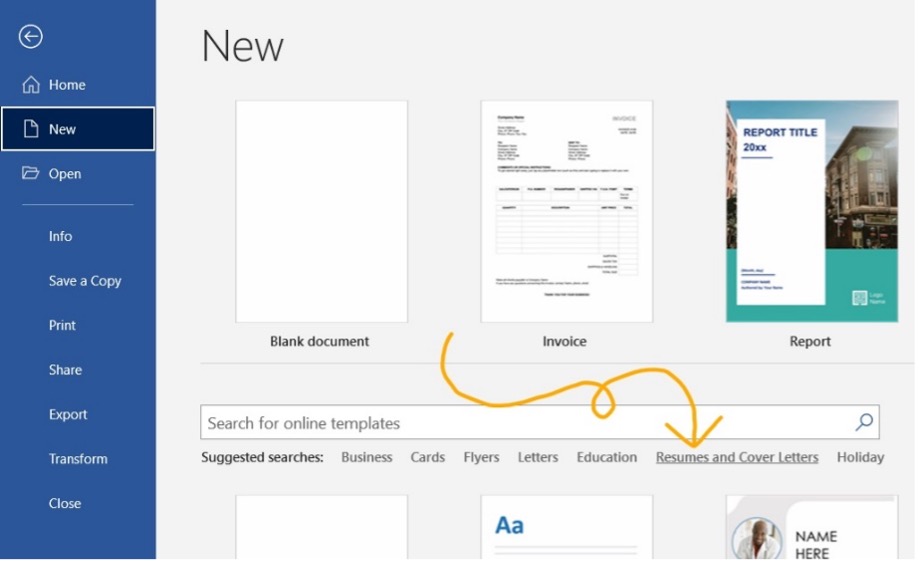
How Should I Format My Resume in Microsoft Word?
The format you choose will depend on your experience level!
There are 3 basic resume formats to choose between:
- Reverse-Chronological: Details your most recent job and works backwards from there. This format focuses heavily on work experience.
- Functional: Focuses on skills and education rather than work experience. This is a good option for recent graduates or applicants with minimal work experience.
- Hybrid/Combination: Combines elements of both the Reverse-Chronological and the Functional. This is a good option for applicants with gaps in their employment history.
Choosing the best format for your needs is key. For more help on this subject, check out our guide on How to Choose the Correct Resume Format in 2024 !
Beautiful resume templates to land your dream job

Make a Resume in Microsoft Word in 7 Easy Steps
First, let’s make sure you can navigate the Microsoft Word ribbon!
The ribbon is the toolbar found at the top of the screen.
It should look something like this:

The main parts of the ribbon you should familiarize yourself with on the Home tab are Font , Paragraph , and Styles .
These are how you will edit the appearance of your text and headers.
You should also familiarize yourself with the Layout tab .
This tab is where you will adjust your margins and add columns!
Once you have taken your time to figure out where all of your tools are, it’s time to begin building your resume!
Important Note: These steps detail how to create a resume in Microsoft Word from scratch. By using one of the program’s pre-made templates, you can bypass many of these steps and simply fill in the pre-made format.
Step 1: Create Your Layout
Let’s begin by visiting the Layout tab .
Here, you can set your margin size and decide if you want to use columns.
Here is a breakdown of these two elements:
We recommend using 1-inch margins on all sides.
This will give you enough white space to keep your resume looking neat without sacrificing too much space.
It will also ensure your formatting looks good on printed versions of your resume.
Columns and Sidebars:
From the columns tab, you will find five options:

- The One , Two , and Three options are how you will create separate columns.
- The Left and Right options are how you will create sidebars! Sidebars are useful because they leave more room for the main text and sections.
From the Home tab , you can edit the following elements of your layout:
Alignment:
Choose between left, center, or right alignment.
We recommend using the left alignment.
Whichever you choose, it is a good idea to keep your alignment consistent across the board.
Line Spacing:
We recommend using 1.15 – 1.5 line spacing for the body text.
For section titles and headers, use 1.5 – 2.0 spacing to help them stand out from the rest of the text.
Use a simple and highly legible font. Try to use only 1-2 fonts throughout your resume.
We recommend the following seven fonts:
- Times New Roman
Step 2: Make Your Title Header
Your title header should contain the following information:
- Your Job Title
- Contact Information
- Professional Social Media Links
Use an H1 header to write your name at the very top.
Use the Normal style to write the rest of your information (see “How Do I Add Different Sections of the Resume on Microsoft Word” below for more information on header styles).
It should come out looking similar to this:
Copywriter Email: [email protected] Phone: (123) 456-7890 Website: Janesmith.com LinkedIn: linkedin.com/in/janesmith
Check out some of our free resume examples to see alternative ways of formatting your title header!
Step 3: Write an Objective or Summary
Following your title header will be your resume objective or summary.
This will be a short statement between 1-5 sentences detailing your desired job title, experience, and career goals.
You will want to write this statement in the Normal style .
However, you may want to use a slightly larger font than the rest of the text in other sections.
This will help your objective or summary statement to stand out.
Here is an example of how this might look with the title header example from before:
Resume Objective: I am a copywriter with over 5 years of experience. working with corporate clients. I am seeking the position of Head Copywriter at your company, bringing with me over 10 major corporate clients.
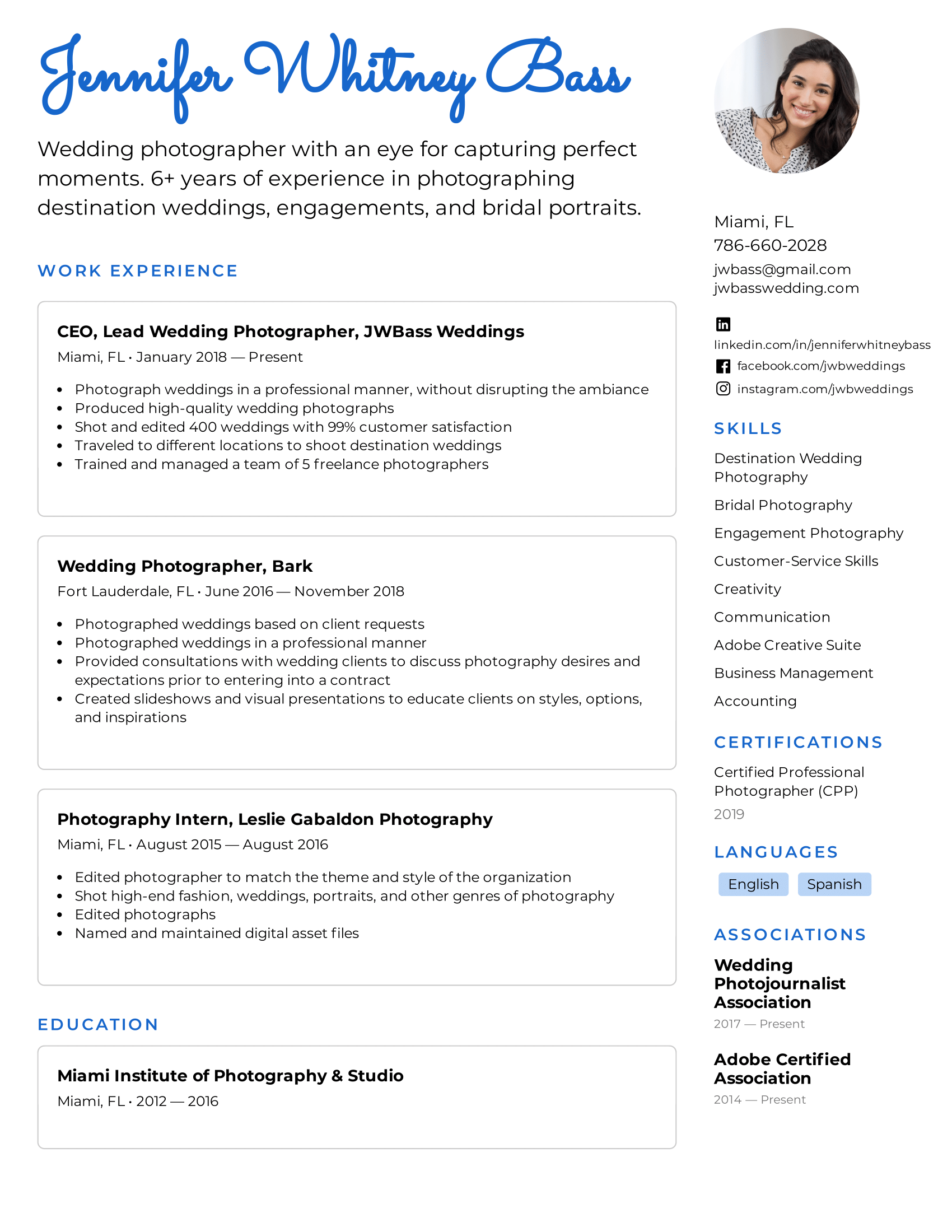
Step 4: Create Your Base Format
By creating a base format, you can save the document as a separate file to return to and fill in again and again.
This will help you to tailor your resume to fit specific jobs!
The idea of the base format is to provide outlined sections with the correct spacing and number of bullet points.
You are essentially creating a skeleton for your resume that you can edit and adjust over time.
By doing so, you ensure you have already allocated the proper amount of space on the resume for each section.
For example, this is what your base Work Experience section may look like:
Work Experience
Job Title 1 , Company Name Date – Date · Descriptive Sentence · Descriptive Sentence · Descriptive Sentence Job Title 2 , Company Name Date – Date · Descriptive Sentence · Descriptive Sentence · Descriptive Sentence Job Title 3 , Company Name Date – Date · Descriptive Sentence · Descriptive Sentence · Descriptive Sentence
As you gain more work experience, you can return to this base format and make changes as need be.
Because you have already outlined the section, you won’t have to worry about reformatting the entire resume to make a few simple changes.
Step 5: Determine Your Section Organization
Once you have built the base format of your resume, it’s time to determine if your sections are in the optimal location.
For instance, if you are creating a Reverse-Chronological style resume you will want your Work Experience section to come first.
Comparatively, if you are creating a Functional style resume you may want your Skills or Education section to come first.
The order and organization of your sections will impact the impression your resume makes on hiring managers.
Step 6: Fill in the Information
Now that you have created the base format of your resume and chosen the optimal organization, it’s time to fill in your information!
When filling in your information, be mindful of the following 3 factors:
- Be Concise: Always use simple sentences that clearly describe your strengths and accomplishments. Avoid complex sentences or overly complicated vocabulary and jargon.
- Use Bullet-Points: In each section, use bullet points to separate each thought or idea. This will make your resume more visually appealing and easier to read.
- Choose Compelling Language: Try to avoid repeating the same words or phrases over and over. Mix it up, use keywords, and find the best action verbs to make your resume sound even better!
Not sure how to make your language more compelling on your resume? Take a look at our list of 350+ Action Verbs to Make Your Resume More Effective in 2024 .
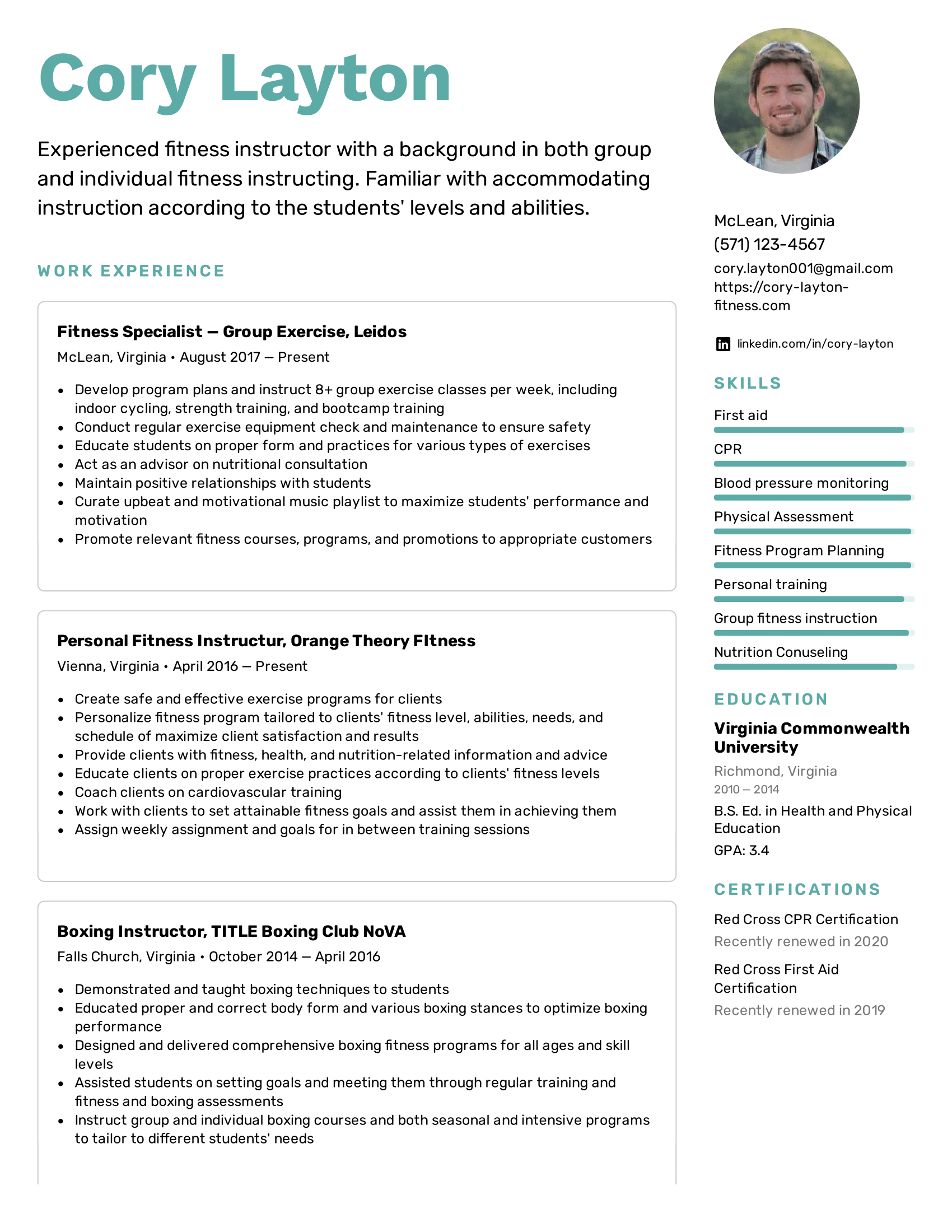
Step 7: Double-Check Your Sections
Once you have completed steps 1-6, look back over your resume and make sure you have included all of the key sections.
You should also take some time to consider what additional sections you could include.
Here are the key sections every resume should have:
- A title header with your name and contact information
- An objective or summary statement
- Work experience
As we have covered, the order of these sections will vary depending on the format you have chosen.
However, each of these sections should always be included in your resume.
There are also some additional sections to consider adding.
Here is a quick list of extra sections that can add some extra flair to your resume:
- Awards and achievements
- Certifications
- Unpaid experiences, such as volunteer work or internships
- Relevant hobbies
How Do I Add Different Sections to a Resume on Microsoft Word?
The way to create different sections on your resume comes in two parts:
- Use an H2 header to create the section titles (Work Experience, Education, Skills, etc.)
- Use the Normal style to create the body of text below the H2 header
Here is a breakdown of how to use the H1, H2, H3, and Normal styles within your resume:
Select the Styles window from the Home tab .
From here, you will have options to create headers.
Your heading options are as follows:
- Heading 1: Use this heading as your largest title. This is what you will use to write your name at the top of the page. Use a bolded font between 16 to 20 pt in size. Use 1.5 to 2.0 line spacing to help the title heading stand out.
- Heading 2: Use this heading to create your section titles. Use a bolded font size between 14 to 16 pt. in size. Make sure these headings are smaller than your title heading. Use 1.5 to 2.0 line spacing to help these headings stand out from the rest of the text.
- Heading 3: Use this heading to create your job titles. Your job titles should be only slightly bigger than the rest of the text. Use a bolded font between 12 to 14 pt. in size. Use between 1.15 to 1.5 line spacing.
- Normal: Use the Normal style to create the body text underneath the heading. Use a regular font between 11 – 12 pt. in size. Use between 1.15 to 1.5 line spacing.

What are the Pros and Cons of Using Microsoft Word to Craft Your Resume?
Microsoft Word is a handy tool to have, especially if your computer comes with the program pre-installed.
Here are 3 pros and 3 cons to using Microsoft Word to create your resume:
- Total Creative Control: When creating a resume on Microsoft Word directly from your computer, you have total control over the design and format.
- More ATS Friendly: Applicant Tracking Systems are designed to read .doc files, the file format used by Microsoft Word.
- Can be Edited by Recruiters: If you are using a recruitment agency, a Microsoft Word file can be easy to edit by recruiters before sending it off to employers.
- The Microsoft Word Learning Curve: If you are unfamiliar with Microsoft Word, there can be a pretty steep learning curve that can cause you frustration.
- Time Consuming: Building a resume from scratch can be highly beneficial, but also highly time-consuming. This can become problematic if you need to create a resume quickly.
- Temperamental Templates: Microsoft Word offers tons of free resume templates. On the surface, this is super useful. However, these templates can be tricky to use. One wrong move can mess up the formatting in a big way and be an even bigger headache to try and fix.
Why Should I Use an Online Resume Template or Resume Builder?
By using a resume template from an online provider, such as Easy Resume, you are more likely to find a template that fits your exact needs.
Plus, online resume templates and resume builders often have more design elements that are easier to use compared to Microsoft Word.
Are you interested in using our online templates or resume builder? Check out our beautifully designed resume templates to build your optimal resume!
Final Takeaways
Microsoft Word offers a lot of capabilities to help you build your ideal resume.
Here are five key takeaways for creating a resume on the program:
- Create a base skeleton for your resume that you can use again and again for different jobs.
- Use different heading styles to help your resume title and section titles to stand out.
- Use the column tool under the Layout tab to create sidebars. Sidebars are great for smaller sections, such as certifications or awards!
- Always use concise and compelling language.
- Consider using a template to build your resume faster.
At Easy Resume, we have designed our resume templates and online resume builder to fit your needs. No matter your level of experience or skill at making resumes, we have the tools to help.
Don’t forget to check out our expansive collection of FREE resume guides and examples while you’re here!
Browse more resume templates that fit your role

Ed is a co-founder of Easy Resume. His background in scaling teams at tech startups over the last decade has given him extensive experience and knowledge around how to hire top talent and build successful teams. He enjoys mentoring, coaching, and helping others reach their career goals. When he's not writing about career-related advice, he's playing with his dog, Lilo, or going on long hikes in upstate New York.
Get inspired with more resume examples
More advice that will accelerate your career path, 15+ key healthcare skills to list on your resume in 2024 (with examples).
Healthcare is a massive and important industry that contains all sorts of professionals. To land a job in healthcare, you must understand what relevant skills employers are searching for. In this guide, we will cover key healthcare skills to include on your resume and why doing so is so important.
15+ IT Skills to List on Your Resume in 2024 (With Examples)
IT is a massively growing industry with tons of potential for professional growth. It’s no wonder why so many applicants are flocking to these jobs! In this guide, we will cover what IT skills are and offer you examples of some of the top skills to include on your resume.
50+ Key Technical Skills to List on Your Resume in 2024 (With Examples)
Including technical skills on a resume is an absolute necessity. These types of skills show employers your quantifiable qualifications. In this guide, we will cover exactly what a technical skill is and some of the best examples to include on a resume.
20+ Key Computer Skills to List on Your Resume in 2024 (With Examples)
With the world becoming more digitally focused, having strong computer skills is more important than ever. In this guide, we will cover what computer skills are and which ones are best to include on your resume.
Read our how-to guides on making your resume perfect
How to write a resume header.
Your resume header is the very first thing an employer will see. Not only does it need to contain the correct information, but it needs to stand out as well! In this guide, we will teach you how to write the ideal header for your resume.
How to Write Your Resume in Reverse-Chronological Order
When setting out to write the perfect resume, choosing a format is an important decision. Reverse-chronological resumes are the standard format, so knowing how to craft one is key! This guide will teach you how to write the best reverse chronological resumes.
How to List Contact Information on Your Resume in 2024
Learn how to format contact information on your resume and what information to share with the hiring manager.
How to Write a Two-Page Resume (with Examples & Tips)
Don't know whether you should write a one-page or two-page resume? Find out when it is appropriate to write a two-page resume and learn how to write it correctly.
Professional resume templates to help land your next dream job.

Facebook • Twitter • Linkedin • Pinterest • Crunchbase
- PRO Courses Guides New Tech Help Pro Expert Videos About wikiHow Pro Upgrade Sign In
- EDIT Edit this Article
- EXPLORE Tech Help Pro About Us Random Article Quizzes Request a New Article Community Dashboard This Or That Game Popular Categories Arts and Entertainment Artwork Books Movies Computers and Electronics Computers Phone Skills Technology Hacks Health Men's Health Mental Health Women's Health Relationships Dating Love Relationship Issues Hobbies and Crafts Crafts Drawing Games Education & Communication Communication Skills Personal Development Studying Personal Care and Style Fashion Hair Care Personal Hygiene Youth Personal Care School Stuff Dating All Categories Arts and Entertainment Finance and Business Home and Garden Relationship Quizzes Cars & Other Vehicles Food and Entertaining Personal Care and Style Sports and Fitness Computers and Electronics Health Pets and Animals Travel Education & Communication Hobbies and Crafts Philosophy and Religion Work World Family Life Holidays and Traditions Relationships Youth
- Browse Articles
- Learn Something New
- Quizzes Hot
- This Or That Game
- Train Your Brain
- Explore More
- Support wikiHow
- About wikiHow
- Log in / Sign up
- Job Application Documents
- Resume Preparation
How to Create a Resume in Microsoft Word
Last Updated: September 25, 2023 Approved
This article was co-authored by Alyson Garrido, PCC . Alyson Garrido is an International Coach Federation accredited Professional Certified Coach (PCC), Facilitator, and Speaker. Using a strengths-based approach, she supports her clients with job search and career advancement. Alyson provides coaching for career direction, interview preparation, salary negotiation, and performance reviews as well as customized communication and leadership strategies. She is a Founding Partner of the Systemic Coach Academy of New Zealand. wikiHow marks an article as reader-approved once it receives enough positive feedback. In this case, several readers have written to tell us that this article was helpful to them, earning it our reader-approved status. This article has been viewed 1,636,222 times.
Resumes detail a person’s work experience, education, skills and achievements. A good resume that is clear, concise and easy to read is essential when looking for a job. Resumes should be word processed and should be neat and tidy. Microsoft Word offers you the option of creating your resume through templates, but you can also create your resume from scratch using Word's formatting features.
Sample Resumes

Creating a Resume from a Template (Word 2003, 2007, 2010, 2013)

- In Word 2007 you will have to click on “installed templates.”
- In Word 2010 it will be “sample templates.”
- In Word 2011 it will be “new from template.” [1] X Research source
- In Word 2013 the templates will be displayed when you click on “New.”

- In Word 2013, after clicking on “New” you will see a number of templates and a search bar which says “search for online templates.”
- After searching you will see a number of different resume templates to try out.

- Here you will be able to look through a number of templates for resumes and cover letters that you can download for free and edit in Word.
- You may have to sign in with your Microsoft online account to use these templates. [2] X Research source

- Be sure to look carefully at the detail of your resume and proofread it thoroughly.
- All of the versions of Word from 2003 to 2013 all come with some pre-installed templates for resumes.

- Click on the “Other Documents” tab, and then select “Resume Wizard.”
- Follow the wizard's instructions. The wizard will walk you through the resume creation process step-by-step
- If you do not see this option, it was not installed when you installed Word, and you will need to run the installation program again to install it.
Creating a Resume Without a Template

- Education and qualifications.
- Work and volunteer experience.
- Skills and qualities.
- It should also include your full contact details and state that references are available upon request.

- Most chronological resumes only cover the last 5 to 10 years of your employment history.
- You may wish to include positions earlier than this if they are appropriate to the job you're seeking.
- This is the format most American employers prefer to see resumes in.

- A combination resume might list your key skills at the top before providing a short account of your experiences.
- This type of resume can be helpful for those entering the job market with little work experience, or for those trying to change careers. [6] X Research source

- The CV is commonly used when applying for positions in Europe, and also when applying for positions at colleges and universities worldwide.
- CVs can be thought of as living documents that records all your work and achievements, which will generally grow and develop over time more than a resume. [7] X Trustworthy Source University of North Carolina Writing Center UNC's on-campus and online instructional service that provides assistance to students, faculty, and others during the writing process Go to source
Writing Your Resume

- If your resume extends beyond one page, ensure that your name is in a header on every page.
- Your email address should appropriate for a job application. Use your own name or initials if possible.
- Don’t use something jokey such as "sly-dude," "foxymama," or "smokinhot."

- For example, you might write that your objective is “To contribute to the design of new word processing software.”
- Alternatively it may state the position you hope to attain, such as “A position as in healthcare policy and research.”
- Objectives have become less common, and you may prefer to provide this information in your covering letter . [8] X Research source

- You can include a bullet point or two to provide a little further information on your specialism, if it is appropriate for the position you are applying for.
- If you achieved any honours or awards as part of your studying or training include these here.

- Use bullet points to make sure it is clear and easy to read or scan through for key words relating to the position you are applying.
- You can include volunteer positions if they relate to the job you're seeking or if you have little paid experience. [9] X Research source

- You can title this section as “Other Relevant Skills”, or just “Skills.”
- This could include proficiency in foreign languages, knowledge of particular computer software and programmes, and any other specific skills not previously mentioned. [10] X Research source
- Take care to avoid repeating yourself. You don’t need to say you have “excellent communication skills” more than once.

- Allow reasonable margins around the edges of the page. Word's default settings are usually sufficient for this.
- Left-align your section headings. You can use single-spacing after a heading and before the section content, and double-spacing before a heading.
- Get your resume down to one page if at all possible. You can try adjusting your line spacing in the Paragraph dialog box, but don’t lose your neat formatting trying to get it down to one page.
- Rethink your words and try to express yourself more concisely.
Expert Q&A

- Don't wait until you're looking for work to update your resume. Any time you have a promotion or significant accomplishment, add the new information to your resume. Thanks Helpful 5 Not Helpful 1
- Always tailor your resume to the type of position you're seeking. You may have to add, rearrange, or delete accomplishments or entire sections according to what the position requires. Thanks Helpful 6 Not Helpful 2

- The appearance and format of your resume is a reflection of your competence; be sure it represents you at your best. Thanks Helpful 5 Not Helpful 1
- Be sure that all the statements in your resume are both factually and grammatically correct and that all words are spelled correctly. Thanks Helpful 4 Not Helpful 1
You Might Also Like

- ↑ https://kb.iu.edu/d/agst
- ↑ https://templates.office.com/en-us/Resumes-and-Cover-Letters
- ↑ http://cla.umn.edu/student-services-advising/career-internship-services/job-search-resources/resume-guide/formatting-0
- ↑ http://writingcenter.unc.edu/handouts/curricula-vitae-cvs-versus-resumes/
- ↑ http://www.career.cornell.edu/story/resumes/parts.cfm
About This Article

1. Open Word and click File . 2. Click New . 3. Click a resume template. 4. Type your own data into each field. 5. Save your resume as a new file. Did this summary help you? Yes No
- Send fan mail to authors
Reader Success Stories
Jan 19, 2017
Did this article help you?

Asrar Ahamed
May 16, 2020
Amisha Khatri
Nov 23, 2016
Jan 9, 2017
Aug 12, 2017

Featured Articles

Trending Articles

Watch Articles

- Terms of Use
- Privacy Policy
- Do Not Sell or Share My Info
- Not Selling Info
Get all the best how-tos!
Sign up for wikiHow's weekly email newsletter
How-To Geek
How to create a professional résumé in microsoft word.

Your changes have been saved
Email Is sent
Please verify your email address.
You’ve reached your account maximum for followed topics.
10 Years Later, I'm Still Using This Popular Android Automation App
This is how i fixed the windows update error 0x80070643, i paid for google's drive storage. here's why i don't regret it, quick links, what is a résumé, using a microsoft word résumé template, crafting a custom résumé in microsoft word, deciding what information to include, organizing that information.
Pressing the send button when sending your résumé to a potential employer can be a nerve-racking experience. We're here to show you how to create a résumé using Microsoft Word and provide a few tips on getting you through the résumé screening process so you can press that send button with confidence.
A résumé, often referred to as a CV (curriculum vitae), is a summary of a person's background and experience, including work experience, education, and even volunteer work, and its most common use is to send to potential employers when searching for a new career opportunity. In fact, though taking on a much different form than that of what you'd expect a résumé to look like today, Leonardo Da Vinci even did this himself, and he is often given credit as the first person to create a resume.
Of course, the résumé has undergone quite the transformation since Da Vinci's 1482 version, drastically so during the age of word processors and digital typesetting in the 1970's---40 years after résumés became an institution. Fast-forward to today and not only do you have your standard .doc or .pdf résumé, but you'll also see people uploading video résumés on YouTube and using social media platforms like LinkedIn to sell themselves to companies.
We should be thankful for these developments because now we can skip the quill and ink and jump straight into Microsoft Word.
Microsoft Word offers a bunch of résumé templates. Some are beautiful; some are not. We'll let you decide which style fits you best, but here's where you can find them.
Go ahead and open Word. As soon as you do, you'll be greeted with several different templates to choose from, ranging from a simple blank document, cover letters, résumés, or even seasonal event flyers. Click the "Resumes and Cover Letters" link under the search box to see only those types of templates.

Now, you'll see all the different resume styles Word has to offer. There are a lot of different styles and color schemes to choose one, so pick what feels right. If you scroll down the list a bit, you'll also see some plainer resume templates designed for different purposes---like an entry-level, chronological, or extended CV style.
Some of the templates are already built into Word; others are a quick, free download from Office.com (and you won't even have to leave Word to grab them). When you click to create a resume, Word will let you know the download size (if it needs to download the template). Click the "Create" button and a few seconds later, you'll be in your document and ready to edit.
That's all there is to it! But what if you didn't find a résumé you liked? Luckily, Word has a few formatting tools to help you craft the perfect résumé.
Before we start, it's important to know that each résumé should reflect a person's personal experience and education. Since everyone's experience is different, it's no surprise that their résumés will be too.
That being said, there are some general aesthetic guidelines for making a résumé that we highly recommend you follow for a professional-looking document .
Go ahead and open up a clean, blank document in Word.
The first thing we'll want to do is set our margins. Go to the "Layout" tab and click the "Margins" buttons.

The drop-down menu displays several different margin options from which to choose. If you can't find the one you're looking for, you can click "Custom Margins" at the bottom and enter your specifications. Let's go ahead and do that.
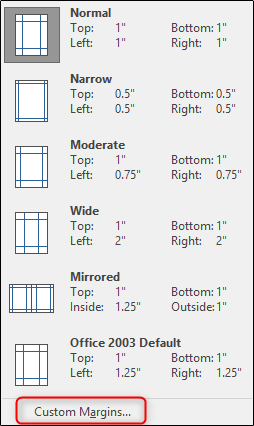
According to the experts, the best margin size is 1" for the top and bottom and 0.63" for the sides. This may seem like an oddly specific number, but the objective is to get as much (relevant) information about yourself as possible on a page without overwhelming the reader. With the above credentials, we leave enough white space on the page for the reader to not feel suffocated.
Click "OK" once you've entered the margin sizes you want.
Now that our margins are set, it's time to start inputting information.
The information you put mainly depends on what you're trying to accomplish and where you are in your professional career. If you have over two years of working experience, then detailing that information is much more valuable than which high school you graduated from or which clubs you were a part of in college. Like a cover letter, your résumé should uniquely cater to the recipient. Dress to impress.
So, which information should you put? We'll give you the overview, and you can decide which areas you should detail.
- Contact Information
- Professional Experience (It's also ok to include any volunteer work at the bottom of this section)
- Additional Skills
For all of these, tailor the information to the job. You don't need to fit irrelevant work experience in there unless not including it would create a gap in your work experience. But if you're applying for a job as an accountant, nobody cares that you delivered pizzas 12 years ago. And you do list out any additional skills, make sure they're relevant to the position for which you're applying. Your high school friend might be impressed by how high you can kick, but your future employer---not so much.
Another thing to remember is that you should always list out your experience in reverse chronological order. That is, list out your most recent experience first, and go back from there.
There're several ways to do this, but arguably the most effective way is by creating headings and then inserting a table for the content of each section. By doing so, you're not only able to move content around in groups instead of individually, which can be a headache in itself, but you're also able to give your résumé a unique touch by adding table designs. In the image below, for example, we've added a dashed border to the left side of the table to create a nice little visual element to tie the different experience elements together.
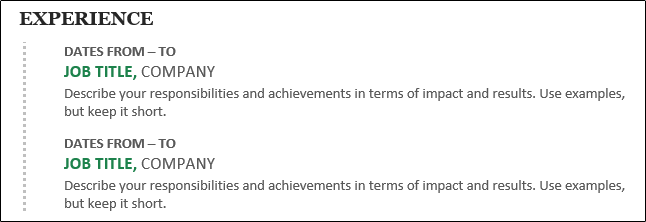
First things first, let's go ahead and find a heading that we like. In the "Styles" section of the "Home" tab, you'll find several default styles. If you can't find one you like, then Word has a feature that lets you create your own. First, click the "More" arrow on the right-hand side of the different built-in styles.
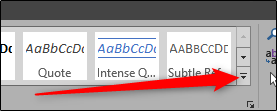
You'll see a menu with three different options. Go ahead and click "Create a Style."

The "Create New Style from Formatting" window will appear. The only thing you can do here is to name the style, so click "Modify."
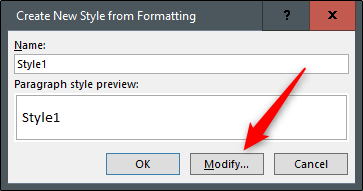
Now you should see a window with many formatting options. For fonts, there's no best option. Just make sure you use something that's clean and readable. "Georgia" is a great example. A 14 pt font size is fine for headings, but make sure it's bold so that each section is easier to find for the reader.
The "Add to the Styles gallery" option will automatically be selected. It's good to leave this option selected so you'll have easy access to your heading for the other sections of your résumé. If you plan to use this heading again in future documents, you can go ahead and deselect "Only in this document," but since we only plan to use it for our résumé, we'll keep that option selected.
Click "OK."
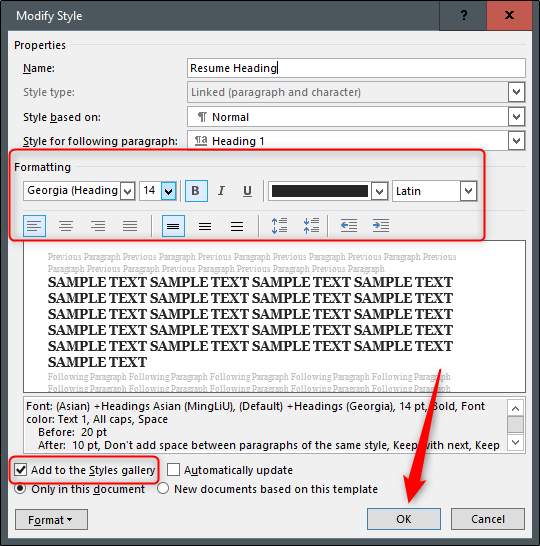
Go ahead and type in your first heading and apply the new style to it. In this example, we'll use "Experience" first.
Now, let's use a table under our first heading so that we can keep all our content lined up correctly. Place your insertion point on the line under your new heading, switch to the "Insert" tab, and click the "Table" button.
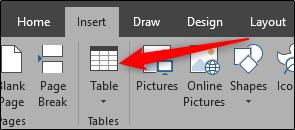
You'll see a 10x8 grid on the drop-down menu. You can create the table size by moving your mouse over the grid and clicking when it's the size you want. For your résumé, you'll need one column and enough rows to contain the separate pieces of information you have to list. For example, if you have three prior jobs to list in the Experience section, you'll want a table that's 1x3.
And here's what it looks like after we've inserted the table into the document.
We'll remove the border lines later. First, go ahead and put in your information. You'll want the "Job Title, Company" text to be 1 or 2 pts larger than the rest of the text but be sure to keep it smaller than the heading of the section. If you want your job title to stand out, you can change the color or make it italic, but try to keep it simple.
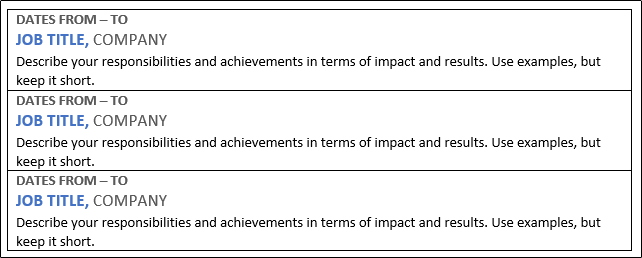
Once that's ready, let's go ahead change the borders of our table. Select the table by placing your insertion point anywhere inside it. Switch to the "Design" tab in the "Table Tools" section of the Ribbon, and then click the "Borders" button.
If you want to keep it simple and remove all the lines of your table, select "No Border." In this example, we're going to give our table a little flavor, so we'll select "Borders and Shading."
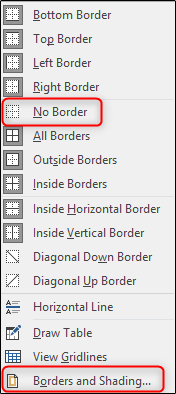
Because we only want to customize the left border of our table, we will select "Custom" under the "Setting" section. This lets us use the "Preview" section to deselect the sides on which we don't want borders. Click the boxes surrounding the preview to turn off all the borders except for the left one.
In the "Style" list, you can select the border design, color, and width you want. Click "OK" when you're ready.
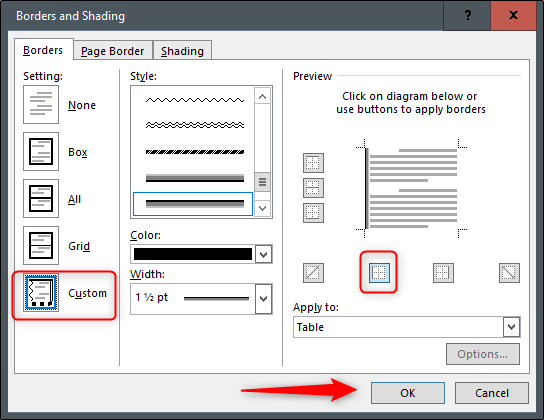
Now we should have an experience section on our résumé that's starting to shape up. A little playing with colors and maybe spacing the table rows a bit, and you should be ready to go.
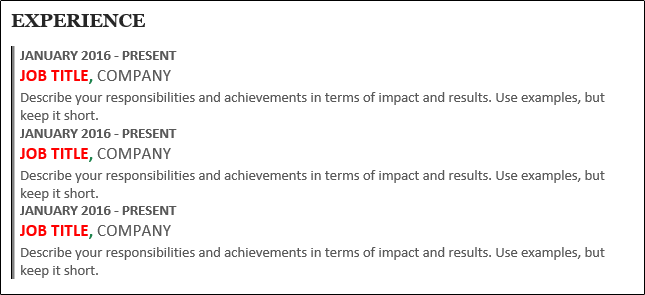
Now, just repeat these steps for the rest of the sections and your professional résumé will be finished in no time!
Image Credit: fizkes /Shutterstock
- Microsoft Office
- Microsoft Word
How to Make a Word Resume in 2024 - 7 Easy Steps

At some point or another - meaning, before online resume builders made our lives easier - most of us have had to make a resume in Word.
Now, making a resume in Word can be tiresome. Not being entirely optimized for the task, it can give you a hard time formatting and styling your resume to your needs - and this is just one of its disadvantages.
That being said, the use of Word is unlikely to drop only because it’s impractical. This means that knowing how to make a resume in Word is still a good skill to have. And if you’re sitting and thinking: “well, this doesn’t make matters any easier” - we hear you.
That’s exactly why this article is here - to teach you how to make a resume in Word, in just a few easy steps.
- Should You Make a Resume in Word?
- How to Make a Resume in Word in 7 Easy Steps
- How to Format your Resume - 3 Pro Formatting Tips
But before we dive into the nitty-gritty details of how to make a resume in Word, let’s go through the downsides of using it to build your resume, and what other easier alternatives you might have in more detail.
Should You Make a Resume in Word?
Microsoft Word might once have been a top resume-building option, but that time is long gone. Although it has ready-made templates, Word in itself was never meant to be a resume builder - this reflects on the end product, which often looks old-fashioned and dull.
Not to mention that it offers very little space for creativity. Try to make a small change in the layout and see the format crumble in front of your eyes.
On the other hand, if you simply use the Word template without customizing it, yours might just become another resume in the crowd that won’t even pass the Applicant Tracking System (ATS) - the software most companies use to filter through countless resumes they receive daily.
Long story short, here are MS Word’s main cons as a resume builder:
Long story short, here are MS Word’s main cons as a resume builder:
- It can be clunky and outdated - chances are, any Word template you choose to use for your resume will look old-fashioned. Technology has changed what is expected of your resume, just as it has changed job-search over the last decade.
- It is not ATS-optimized - the software that most recruiters use not to waste time looking at the resumes? Well, most Word templates are not optimized for it. This means that you can be the fittest candidate for the job and not even get invited to an interview.
- It’s time-consuming - making changes to the layout of a Word resume template is a nightmare.
Everyone knows what happens when you move an image in Word:
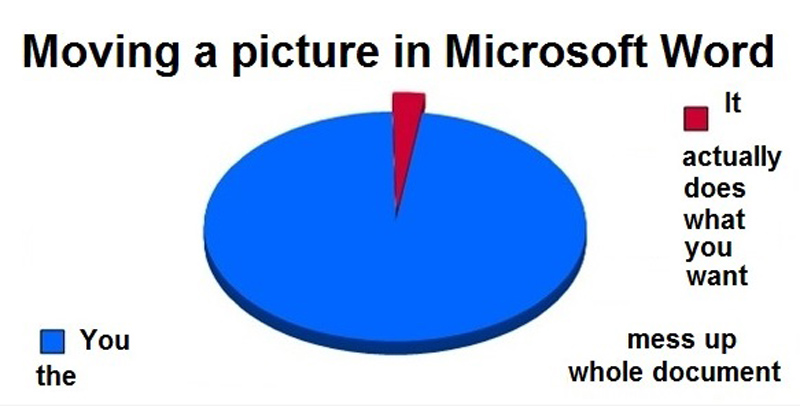
It’s exactly for these reasons, as well as the added efficiency, originality, and time preservation, that online resume builders are the obvious choice for creating your resume.
Novorésumé’s online resume builder is fast, easy to use, and perfect if you want to land that interview. You can start building your resume immediately just by clicking on the link, or you can pick one of our free resume templates , according to your needs.
Step #1: Pick a Word Resume Template
The first step in making a resume in Word is accessing its free resume templates. How you access the templates may change depending on the Microsoft Word version you’re using, but what you ultimately need to do is the following:
Open Word.
Select one of the Resume templates Word suggests, or simply search for “resume” and you’ll find a bunch more.
Choose the resume template that best fits your qualifications and professional profile.
Click “Create.”
You’re good to go: the template should appear as a Word document ready to be filled with your personal information and all other relevant sections.
Step #2: Create a Resume Header
From this point on, things should be pretty easy to pick up.
Start filling up your resume from the top, which is where the resume header is located. Traditionally, the header should include the following information:
- First and last name
- Phone Number
- Location (Street Address, City, State)
You may notice the lack of optional information in this resume template, such as your professional job title , your LinkedIn URL , or social media links.
If you feel like that info will significantly improve your resume, look for a Word template that includes them, or manually add them to the template you’ve already chosen. We’ll go over some formatting techniques to improve your resume template later on in the article.
Step #3. Include a Resume Summary or Objective
Next, you need to describe your professional experience or professional goals (in case you lack the experience) through the resume summary or objective.
Write a resume summary or resume objective - depending on which one best fits your resume - and try to express yourself in a way that will keep the recruiter’s attention for more than the traditional 7 seconds .
Quick recap: a resume summary is a 2-3 sentence overview of your career and is used in 90% of the cases. A resume objective is more commonly used among those with little professional experience or those who are changing careers and describes your professional goals.
Step #4: Create a Compelling Work Experience Section
This is where things get serious.
The work experience section is the most important part of your resume for obvious reasons and usually plays a decisive part in the recruiters’ decisions. So just filling up the gaps in the experience section of the Word template won’t be enough. You should try to make this section as compelling as possible - following some of the tips provided below.
But first, the basics. As with any standard format, the experience section should include the following components:
- Job title and position
- Company name and location
- Dates of employment
- Achievements and responsibilities
Again, how the resume looks in Word will depend on the template that you have chosen.
Obviously, the template lets you add as many professional entries as you wish - but that doesn’t mean you should go overboard. List your experience in reverse-chronological order, meaning: start from the latest and move back in time, based on the amount of professional experience you possess.
There are, of course, a couple of pro tips that you should follow even as you use the Word templates to make your experience section more compelling.
Pro Tip #1 - List achievements over responsibilities
Notice the example above.
Instead of responsibilities, we have opted to list achievements. Listing achievements over responsibilities whenever possible is one of the best ways to stand out in the eyes of recruiters. That’s because responsibilities are similar for one type of job, while achievements show exactly what you can contribute to the position .
Pro Tip #2 - Tailor your resume to the job you are applying for.
Another good practice is tailoring your resume to the job you are applying for. This can help you go through the ATS and land your resume right on the recruiters’ tables.
If you want to know exactly what information to include in your resume, how and when to list achievements over responsibilities, and how to tailor your resume to your job, head over to our complete guide on how to write a resume .
Step #5: Add Your Educational Background
Things should get quite easy after you get your professional experience section out of the way.
The education section of your resume should include the following:
- University name and location
- Years attended
- Program name / Degree obtained
Optionally, you can include your GPA, Minor degrees, or any special award or academic achievement. Our advice is to include them only if you are a recent graduate or entry-level professional with not much else to include in your resume, or if your education history is truly outstanding.
Step #6: Make Sure to Include Your Skills
At this point, you can consider most of the work done!
Now that you have reached the skills section, things get even easier. Make a bullet or numbered list of your hard and soft skills and you’re good to go.
Hard skills are usually measured through experience levels - you can place your experience level (usually categorized into Beginner/Intermediate/Advanced or Expert ) into brackets, so you don’t take up too much space within the resume.
Pro Tip #3 - Tailor the skills and qualifications on your resume to the job
Take a look at the essential skills required on the job ad and see if you can incorporate them into your list of skills.
Step #7: Include Optional Resume Sections
Congrats - you can finally stretch your legs and even allow yourself a little pat on the back.
The additional sections are not mandatory in a resume, so if you’ve reached your resume space limit, you can just call it a day and save your resume.
They are, however, a great way to show off additional assets such as languages, hobbies and interests, and even volunteering experience on your resume !
- Remember to also determine your language knowledge levels. Those are Native , Fluent , Proficient , Intermediate , and Basic.
In the off chance that you still have some space left - considering resumes should be 1-2 pages at most and that Word templates are not as good at saving space as online resume builders - you can include the following optional sections:
- Certifications and Awards
- Publications
Follow the same practice as with the skills section, and you’re good to go!
How to Format Your Word Resume
With all the essentials covered, let’s go over some formatting tips such as fonts, line spacing, and headings so that your Word resume looks as uniform and clean-cut as possible.
Best Resume Fonts in Word
We cannot repeat this enough - the resume font you use, matters. It matters just as much as first appearances matter and we all know they do, a lot.
The font that you decide to use will impact your resume readability whether you like it or not, so you should use a font that will help you stand out, but not in a bad way. What’s a bad way? Comic Sans and other similarly-looking comic fonts.
The usual Times New Roman, point-12, formula, on the other hand, will just blend you with the crowd.
Instead, consider using one of the following recruiter-friendly fonts which will complement your resume both on-screen and in printed form, according to Business News Daily :
- Book Antiqua
- Trebuchet MS
Optimal Line Spacing for a Word Resume
The good thing about the Word resume template is that it usually has fonts and line spacing covered for you, yet it’s still good to know that the best line spacing for resumes is 1 or 1.15 between text and double lines after headings.
Feel free, however, to play around with line spacing when it comes to adjusting your resume layout.
Headings in a Word Resume
Again, Word templates do a good job of making the headings stand out. As a rule of thumb - and as is noticeable in the above examples - headings should be bigger than the rest of the text. So, if you’re using a 12 pt text, consider adjusting the headings between 14-16 pt.
You can also underline or bold each resume section heading, or even use a different font, but as we always advise: don’t go overboard and try to maintain the style of the Word resume template that you have chosen.
And by now, you should have a complete resume in Word that looks like this:
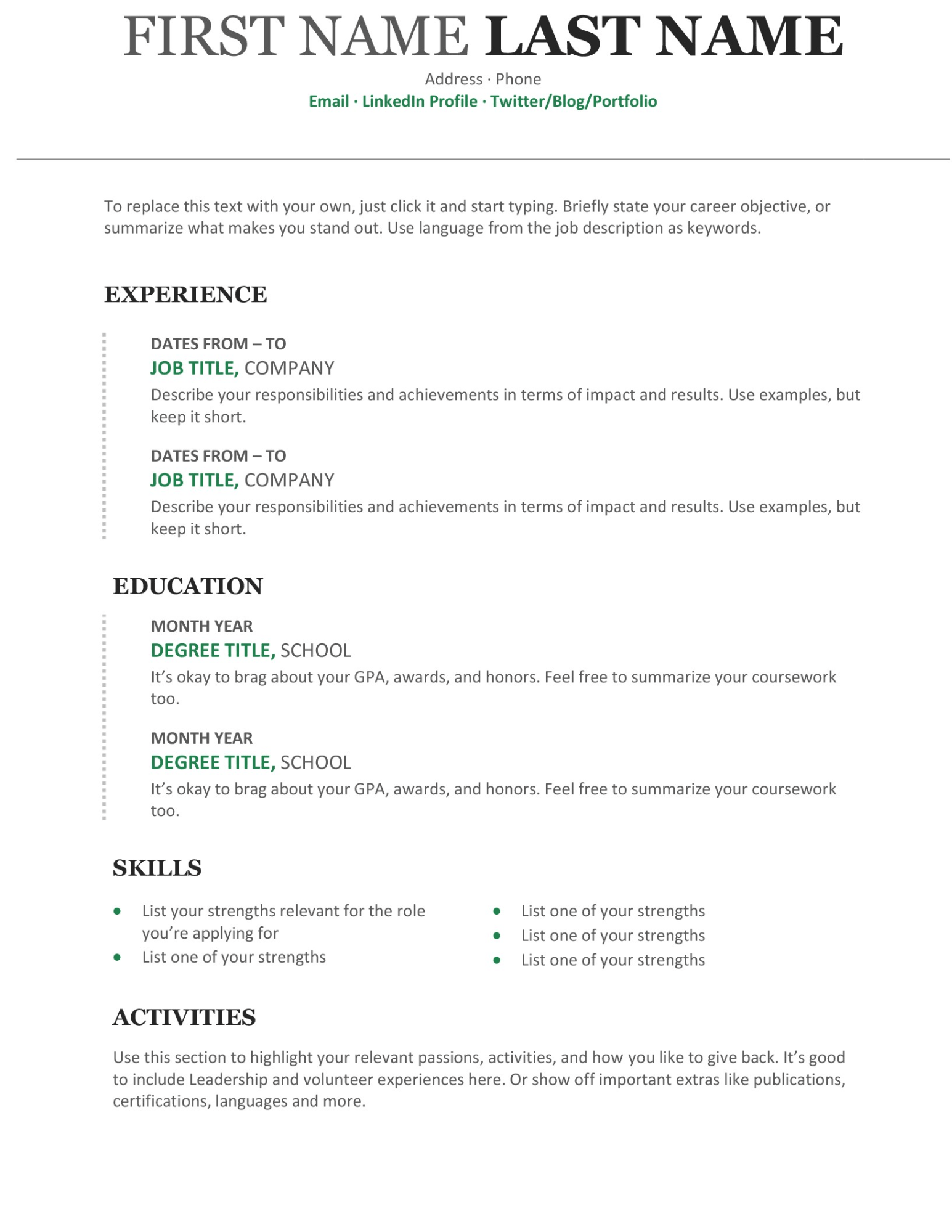
Key Takeaways
Well, here you have it - your nicely tailored resume in Word, ready to land you that job interview.
Although not the easiest task, we are convinced this article has given you all the necessary information on how to make a resume in Word and the confidence to do so easily.
Here’s what’s good to remember:
- Order your resume sections properly, usually in reverse-chronological order.
- Make sure that your section headings stand out from the rest of the text, by usually using a larger font size.
- Check if your chosen font, line spacing, and margins are aligned, readable, and professional-looking.
- Opt for an online resume builder such as the one Novorésumé provides for a more modern, time-saving, and HR-friendly resume.

To provide a safer experience, the best content and great communication, we use cookies. Learn how we use them for non-authenticated users.
Your current User-Agent string appears to be from an automated process, if this is incorrect, please click this link:
How to Create a Professional Resume Using Microsoft Word

Your changes have been saved
Email Is sent
Please verify your email address.
You’ve reached your account maximum for followed topics.
Manage Work or Personal Workflows With This Excellent Project Organizer App
The 6 most underrated photo editing effects you should be using, when does facebook messenger notify others about screenshots.
Microsoft Word offers templates and tools for creating resumes. Whether you are new to the workforce or an experienced professional, you have a variety of options.
Many companies use Application Tracking Software (ATS) which looks for keywords and specific color and design format in your resume. It can be rejected by ATS or a recruiter if the resume is not optimized and lacks standard design.
Sharing your work experience and skills is the first step in getting the attention of a recruiter. Let's understand how to create a professional resume in Microsoft Word.
Why Use a Resume Template?
Designing a resume from scratch and adding suitable content is a time-consuming process. Resume templates in Microsoft Word are created by professional designers and, therefore, in line with industry standards.
Using them can increase your chance of making a good first impression and meeting the required guidelines.
Choosing the Right Template
Now that you have learned the importance of using a template, let's see how to choose the right one. Microsoft provides an array of templates for diverse job profiles. Usually, designers or artists use templates with prominent visual elements.
These elements help in showcasing their portfolios, such as artwork, wireframe designs, or photographs. In contrast, technical or sales professionals prefer a design with a maximum of two colors and a simple layout.
Creating a Resume
Let's see how you can find the right template and create a resume.
- Open Microsoft Word and click New .
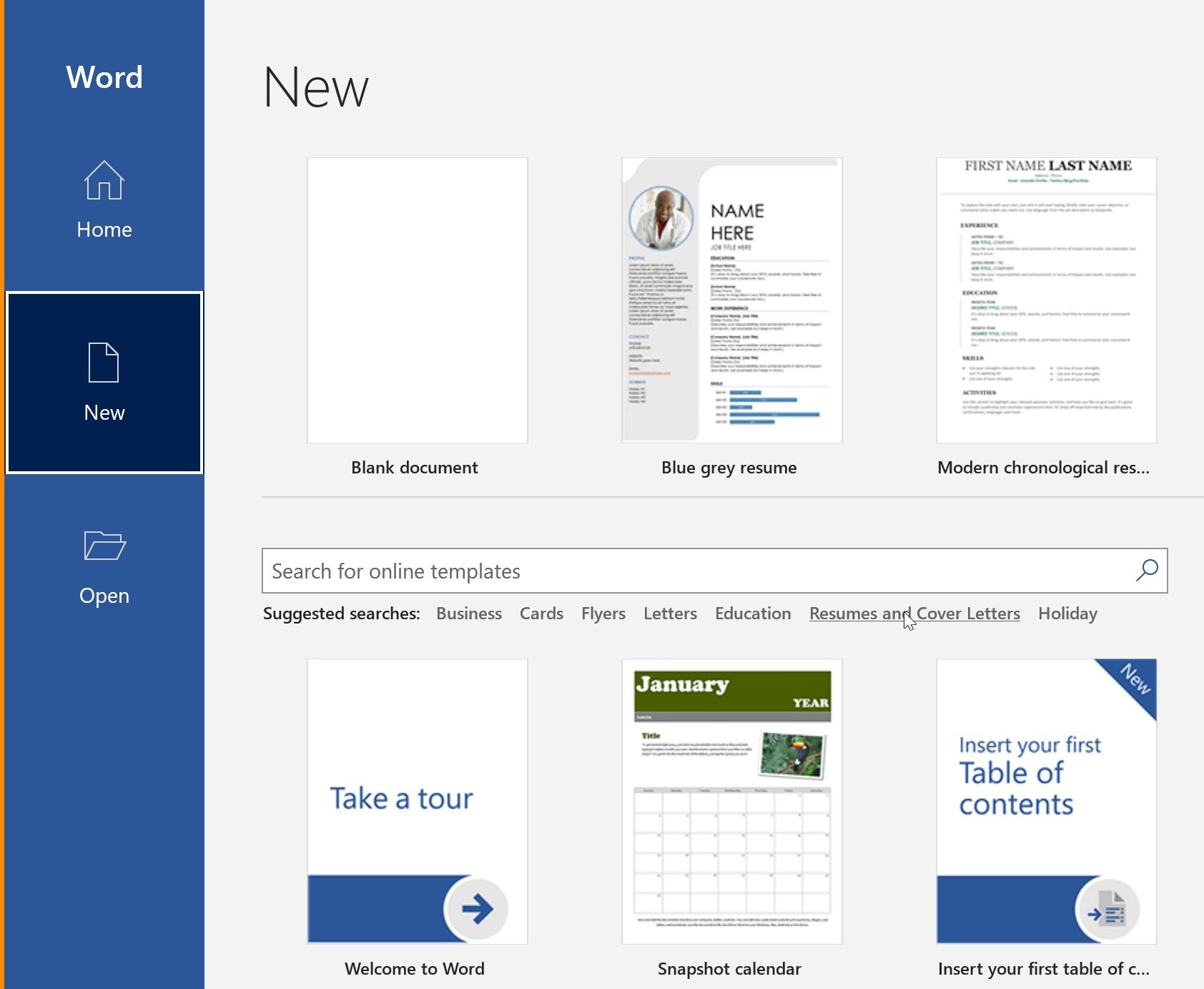
- Browse the list and click the Pin option to mark a few templates for future reference.
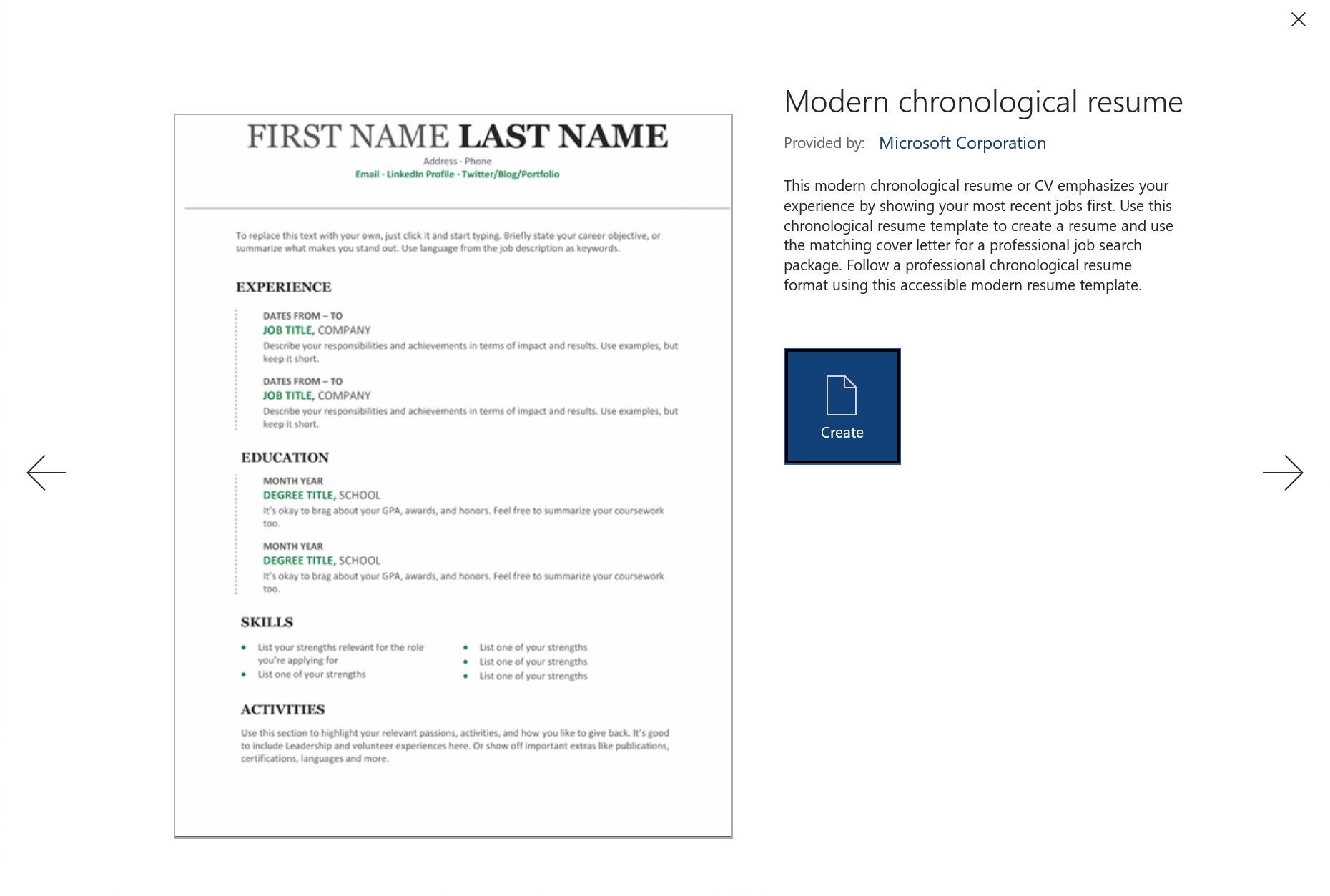
- After you have finalized a template, click Create .
- Remove sections that are not relevant. For example, if you are a graduate, the Experience section may not be relevant.
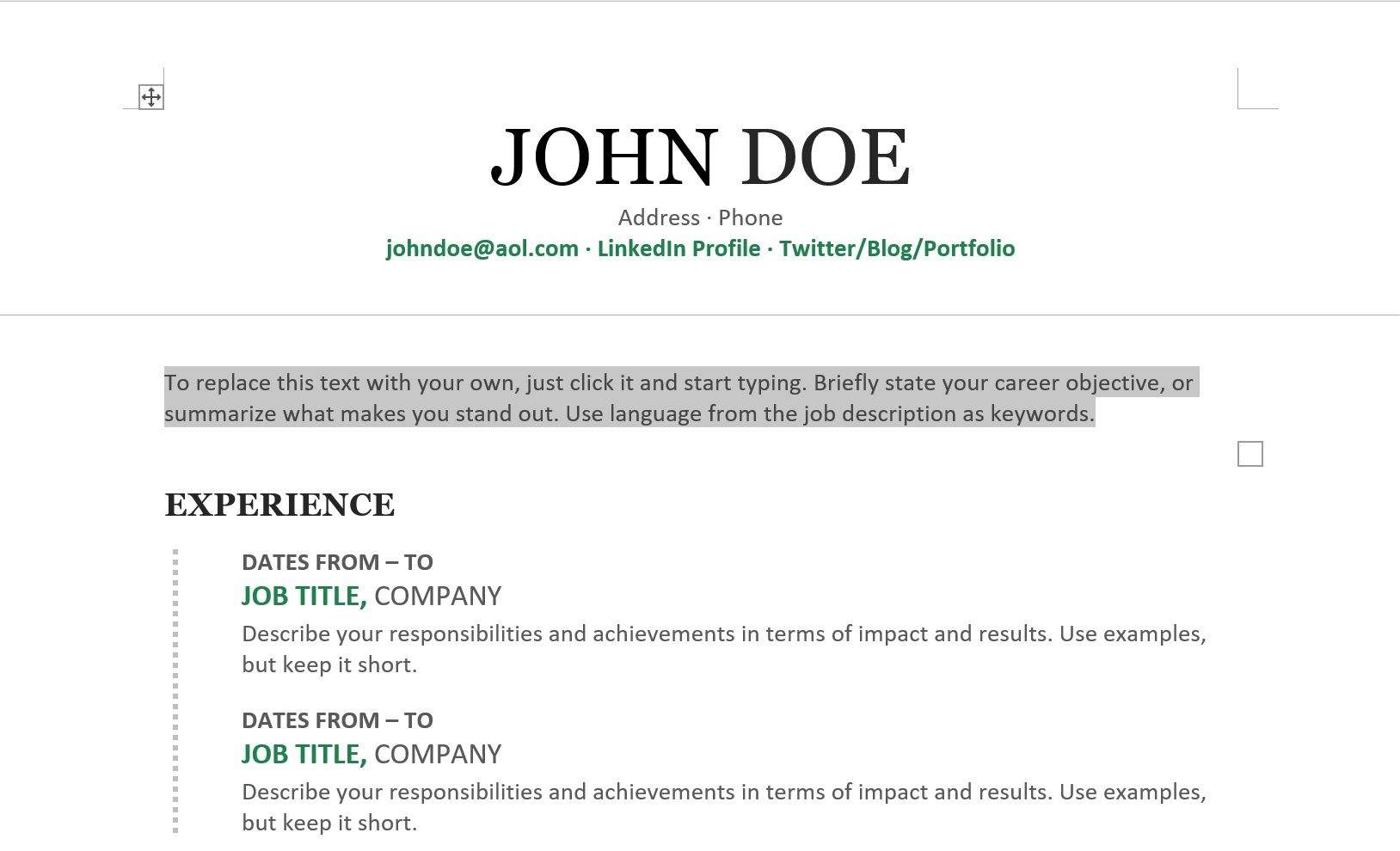
- Click Save .
Using the Resume Assitant by LinkedIn
When you create a resume in Microsoft Word, the Resume Assistant is displayed on the right panel. The assistant shows samples of popular LinkedIn profiles relevant to you.
If you face writer's block or need ideas to enhance your content, follow these steps to use the assistant.
- Enter your LinkedIn login credentials, role, and the preferred industry.
- Click Get Started . Examples of public profiles based on your preferences are displayed.
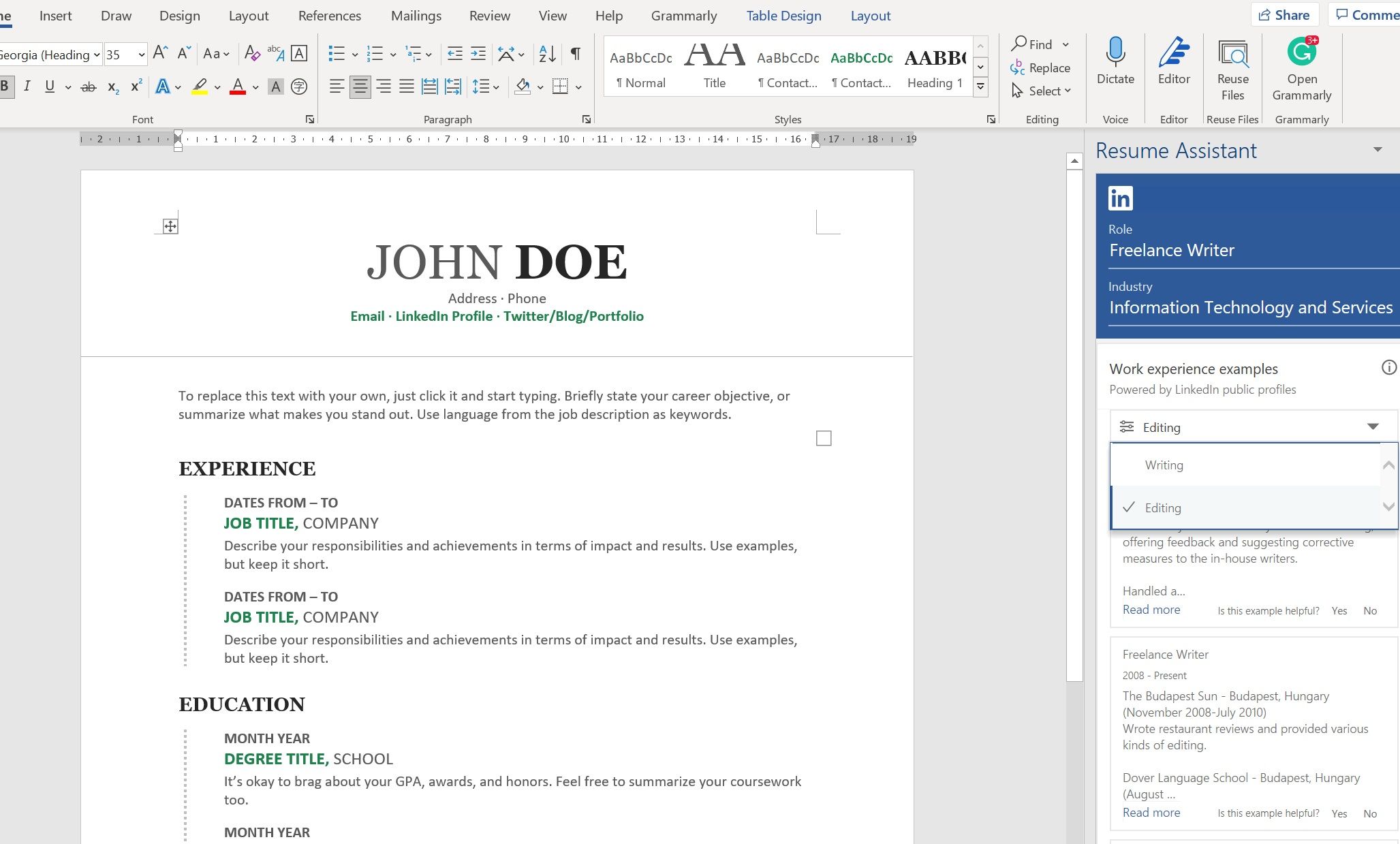
- Click the Read More option to view the details.
Polishing Your Resume
Incorrect grammar creates a poor impression on a recruiter. That's why editing and proofreading the resume is crucial. You can either use the in-built Spelling and Grammar Check feature in Microsoft Word or explore other grammar checkers .
You can also switch to Read Mode or Print Layout to review without distractions. This approach will help you spot errors.

Lastly, print your resume. Reading in paper format highlights spacing issues, missing periods, and incorrect formatting.
Alternative to Microsoft Word 365
Now that you have learned to create a resume in Microsoft Word, you can share it with recruiters or upload it to job portals. If you do not have access to Microsoft Word, alternate web-based software can help you get started.
You can also use external services to align your resume with the job description . These services will ensure that your resume is aligned with your role and meets industry standards.
- Productivity
- Job Searching
Protect your data
This site uses cookies and related technologies for site operation, and analytics as described in our Privacy Policy . You may choose to consent to our use of these technologies, reject non-essential technologies, or further manage your preferences.
- Resume and Cover Letter
- Step-by-Step Guide on...
Step-by-Step Guide on Creating your Resume Using MS Word
9 min read · Updated on December 08, 2023

Microsoft Word is the best program to use when creating your resume. Here's how to do it so that your resume gets past the Applicant Tracking System - ATS and impresses hiring managers.
Microsoft Word comes with some very attractive templates that are ready to use and allow you to fill in the blanks. The bad thing is the templates offered by Word are not usually ATS-friendly. It is best to create your resume from scratch. You can do so without being an expert at using Word or knowing all of the formatting options the program offers.
A simple online search about creating a resume from scratch returns millions of results. Choosing the right set of instructions can be daunting. So, instead of going down that rabbit hole, follow this step-by-step guide on creating a resume using MS Word.
MS Word resume templates
It can seem like an easy answer to pick a template offered by Word. You open the program, click templates, and are presented with hundreds of options. However, considering that ATS can't properly parse information from resumes that have text boxes, columns, images, and charts, those templates are not going to serve you well .
Submitting a non-ATS-friendly resume is the best way to have your resume rejected for a job. When your resume is rejected by the ATS software, the human beings at the company don't even know you exist. It is one of the top reasons job seekers are ghosted by companies.
Format your overall document before you start typing
Believe it or not, an ATS will scan resumes for everything from keywords, experience, and education to margin width and font. There are some pre-typing formatting options you'll need to set to ensure that the ATS can read your document.
Set your margins so that they are no narrower than 0.5 inches all the way around. Alternatively, you can use 0.75 and one-inch margins if you prefer.
Choose the font you want to use . You can use more than one font in your resume to distinguish between headers and body text, but use no more than two separate fonts.
On the “Paragraph” formatting ribbon, set your line spacing to “Multiple” at 1.06 and enter “6 pt” in the “Before” box to ensure that your lines are squished together. You want to create some white space in your resume.
Setting the right formatting options ahead of time can save you some headaches when you're finished typing the text.
As you type out your resume information in your resume, use the “Font” and “Styles” formatting ribbons to customize things like font size, colors, headers, and section separators. Your resume should contain the following sections :
Other (e.g., Affiliations, Licenses, Certifications, Volunteerism)
Your contact section
Type your name on a line by itself. Typically, you want your name to be larger than the other text on the document. You can even put it in all caps or small caps to help it stand out. On the next line, type your city, state, zip code/postal code, phone, email, and any online portfolios you want hiring managers to know about.
It is no longer customary to include your full address. There have been instances of discrimination against job seekers based on their home addresses. It is critical, though, that you include your zip or postal code. Hiring managers can query the ATS for resumes within a radius of a zip code. If your zip code is missing, your resume doesn't get included.
If you use the “Intense Quote” style, your name and contact information will be set apart from the rest of the document with a border along the top and bottom of the text. Highlight your name to increase the size of the font and make it bold.
Title and summary section
As you write the title and summary of your resume, make sure that it is future-facing and targeted to the job to which you want to apply. Type the title on a line by itself and, like your name, put it in all caps, small caps, larger text, and bold text so that it stands out from the rest of the words on the page. It's also a good idea to center it on the line. You can also change the color.
Some rules to use when applying color to your resume:
Color draws attention to the important parts.
Use bright colors (e.g., blue and green) for headers and contact information.
Use complementary colors (e.g., lighter shades of blue and green) for subheadings, position titles, and degrees.
Avoid using red on your resume as red is associated with stopping. You don't want to give someone a queue to stop reading your document.
The summary paragraph should be three to five sentences in length with a focus on what you bring to the table in alignment with relevant keywords from the job description. Be specific, but be concise. Focus on how much experience you have, a few things that you're really good at, and include at least one achievement.
Your skills section
Your contact section, title, and professional summary won't have headers. The skills section is where you'll start including headers to separate content. Type the word “Skills” on a line by itself. Follow the same style for each of the other sections in your resume.
Then, on the next line list out your professionally relevant and job-specific skills. Keep the list to no more than 12 skills and be sure to use a strong mix of hard and soft skills .
Your professional experience section
This is where the bulk of your resume content should appear. In order to properly write your experience section, you should use the chronological resume format . This simply means that you start with your current or most recent job and work backward. There are some general rules of thumb to keep in mind when writing the experience section of your resume.
How to lay out the information for each job: Start with the name of the company and the timeframe you were employed there. It's best to use the MM/YYYY format for your jobs. After that, list your position title followed by three to five achievement bullets. Make sure that each bullet starts with a verb so that you have an action-based resume.
Stick to the last 10-15 years of experience: A great resume represents approximately 10 years of experience. It's okay to go back 15 years, but it's recommended that you avoid going further than that. You can certainly list older experiences under an “Early Career Experience” title, but the roles in that list won't contain bullets detailing your accomplishments.
Use stacking to list multiple roles at the same company: When you have progressed through more than one position within a single company, you'll list the company name first with the total amount of time you were employed there. In the next line, you'll list the last role you had with the company and the time you held that position followed by your achievement bullets. After those bullets, list the previous role you held with the company with the time you were in that role but don't list the company name again. Here's what that looks like:
ABC Company | 03/2007-Present
Senior Leader (05/2015-Present)
Experience that relates to the job to which you're applying.
Example(s) of projects or situations where you used this skill.
1 to 2 accomplishments or measurable results showing your expertise with this skill.
Associate Leader (03/2007-05/2015)
Your resume isn't meant to be a record of your professional life's events.
Talk about achievements that will intrigue a hiring manager to call you for an interview.
Anytime you can use numbers, it's best to do so.
Your education section
End your resume with an education section, which includes your education, professional development, and any credentials you may possess. List graduation dates only if you're still in school or graduated within the last year. You should also spell out acronyms (e.g., Master of Business Administration rather than MBA). You can put the acronyms in parentheses after the full spelling. This holds true for degrees and school names.
If you didn't graduate, you can still list your higher education on your resume. After you type out the degree you were pursuing and the name of the school, put verbiage that indicates the degree is unfinished. Here's an example:
Bachelor of Science in Business Management | ABC State School | Expected completion: MM/YYYY
When you didn't finish and know you're not going back, simply put the number of credit hours you completed in the place of the “Expected completion” text:
Bachelor of Science in Business Management | ABC State School | 98/120 Credit Hours Completed
Additional sections that may appear on your resume
Some jobs require you to be a member of a particular organization. You may have completed some career-related research or have articles published to which you want to call attention. Put a relevant header for any extra information that you want on your resume and type out the information.
Formatting headers
Now that you have the content written, it's time to make it look pretty. It's easy to update the text of each header title by enlarging the font and using bold. You can do more, though.
- Shading: Highlight the “Skills” header and click the down arrow next to the paint bucket icon on the “Paragraph” formatting bar. This will allow you to change the shading behind the header. Be sure to use something that complements any color you've already used and don't let the shading make it so you can't read the header text.
- Borders: With the word “Skills” still highlighted, click the down arrow next to the borders button on the “Paragraph” formatting bar (it's right next to the paint bucket icon). Choose to add a top or bottom border (or both) to your header. The choice is completely yours to use one or both borders.
Whatever formatting you decide to finish with on the “Skills” header needs to be repeated on all headers to ensure a level of consistency within your resume. The only header that wouldn't need formatting is the line you created if you decided to list “Early Career Experience.” You can simply bold that and leave it as simple text.
Now you have a beautifully formatted, from-scratch resume. In the end, all you needed to know how to do was bold text, change the font, and format shading and borders.
If you have questions, TopResume has a team of expert resume writers standing by.
Recommended reading:
- The Hidden Dangers of Using Microsoft Word Resume Templates
- What's an ATS-Friendly Resume? And How to Write One
- How to Write a Chronological Resume (Tips + Examples)
Related Articles:
Do Hiring Managers Actually Read Cover Letters?
How to Create a Resume With No Education
Why You Lose When You Lie on Your Resume: Learning From Mina Chang
See how your resume stacks up.
Career Advice Newsletter
Our experts gather the best career & resume tips weekly. Delivered weekly, always free.
Thanks! Career advice is on its way.
Share this article:
Let's stay in touch.
Subscribe today to get job tips and career advice that will come in handy.
Your information is secure. Please read our privacy policy for more information.
How to Make a Resume on Word: A Step-by-Step Guide for Success
Creating a resume on Word is a straightforward process that can help you land the job you want. By following these steps, you’ll be able to design a polished, professional resume in no time. Let’s dive into the step-by-step process, and soon you’ll have a resume that’s sure to impress.
How to Make a Resume on Word
Creating a resume on Word will help you professionally present your skills and experience. Here are the steps to design a standout resume:
Step 1: Open Microsoft Word
Open Microsoft Word to begin your resume.
You’ll need a blank document to get started. If you don’t have Word, you can use the online version by logging into your Microsoft account.
Step 2: Choose a Resume Template
Select "New" from the File menu and choose a resume template.
Word offers various templates designed by professionals. Pick one that fits the industry you’re targeting and your personal style. This choice sets the tone for the rest of your resume.
Step 3: Fill in Your Contact Information
Enter your name, phone number, email, and address at the top of the resume.
Your contact information should be easy to find. Make sure your email address is professional, and double-check for any typos.
Step 4: Write a Summary or Objective
Add a brief summary or objective statement beneath your contact information.
This section should be a few sentences that highlight your career goals or summarize your professional background. Keep it concise and focused on why you’re an ideal candidate.
Step 5: List Your Work Experience
Create a section for your work experience, listing your most recent job first.
Include the company name, job title, and dates of employment. Add bullet points to describe your responsibilities and achievements. Quantify your accomplishments when possible, such as "Increased sales by 20%."
Step 6: Add Education Information
Include a section for your education, starting with the most recent degree.
List the name of the school, degree obtained, and dates attended. If you have relevant coursework or honors, mention them here.
Step 7: Highlight Skills
Create a section for your skills, focusing on those relevant to the job you’re applying for.
This can include both hard skills (like proficiency in Word) and soft skills (like communication). Tailor this section to match the job description.
Step 8: Save and Review
Save your resume and review it for errors.
Make sure to save the document in a common format like .docx or PDF. Proofread carefully, as typos can make a poor impression.
After completing these steps, your resume will be ready to share with potential employers. Always customize your resume for each job application to make the best impression.
Tips for Making a Resume on Word
- Use Clear, Professional Fonts: Stick to fonts like Arial or Times New Roman for readability.
- Keep It Simple: Avoid using too many colors or graphics which can be distracting.
- Tailor Your Content: Customize your resume for each job application to highlight the most relevant experience.
- Use Action Verbs: Start bullet points with action verbs like "Developed," "Managed," or "Led."
- Proofread Thoroughly: Double-check for grammar and spelling errors to ensure professionalism.
Frequently Asked Questions
How long should my resume be.
Typically, a resume should be one to two pages long. This length allows you to include enough detail without overwhelming the reader.

Should I include a photo on my resume?
In most cases, you shouldn’t include a photo unless the job specifically requests it. Photos can introduce bias and are often unnecessary.
How do I format bullet points in Word?
Use the bullet point feature in the toolbar. Keep bullet points concise and start each with a strong action verb for clarity.
Can I use color in my resume?
Yes, but use it sparingly. Choose one or two colors that complement each other and keep the rest of the text in black for readability.
What if I don’t have much work experience?
Focus on your skills, education, and any volunteer work or internships. Highlight transferable skills and accomplishments relevant to the job you’re applying for.
- Open Microsoft Word.
- Choose a resume template.
- Fill in your contact information.
- Write a summary or objective.
- List your work experience.
- Add education information.
- Highlight skills.
- Save and review.
Crafting a resume on Word doesn’t have to be a daunting task. By following these simple steps, you can create a polished and professional resume that stands out. Remember to keep your resume updated and tailored for each job application. Take advantage of Word’s features to enhance the look and feel of your resume.
For further reading, consider looking into more advanced Word features, such as inserting tables or using advanced formatting options. Each tweak you make can help your resume shine a little brighter.
So, there you have it! Now it’s your turn to open up Word and get started on crafting a resume that will capture the attention of your future employers. Good luck!

Kermit Matthews is a freelance writer based in Philadelphia, Pennsylvania with more than a decade of experience writing technology guides. He has a Bachelor’s and Master’s degree in Computer Science and has spent much of his professional career in IT management.
He specializes in writing content about iPhones, Android devices, Microsoft Office, and many other popular applications and devices.
Read his full bio here .
Share this:
- Click to share on Twitter (Opens in new window)
- Click to share on Facebook (Opens in new window)
- Click to email a link to a friend (Opens in new window)
- Click to share on LinkedIn (Opens in new window)
- Click to share on Reddit (Opens in new window)
- Click to share on Pinterest (Opens in new window)
- Click to share on Tumblr (Opens in new window)
Related posts:
- How to Add a Bullet Point in Google Docs
- How to Make Bullet Points in Google Docs: A Step-by-Step Guide
- How to Make a Sub Bullet Point in Google Docs: Step-by-Step Guide
- How to Add Bullet Points in Word: A Step-by-Step Guide for Beginners
- How to Add a Bullet Point in Word: A Step-by-Step Guide
- How to Add Bullet Points in Word with Keyboard: A Step-by-Step Guide
- How to Do Bullet Points in Word: A Step-by-Step Guide for Beginners
- How to Fix Bullet Points in Google Docs: A Step-by-Step Guide
- How to Add Google Certificate to Resume: A Step-by-Step Guide
- How to Fit Resume on One Page in Google Docs: A Step-by-Step Guide
- How to Make Bullet Points Smaller in Google Docs: A Step-by-Step Guide
- How to Add Bullet Points in Google Sheets: A Step-by-Step Guide
- How to Use Google Job Search: A Step-by-Step Guide
- How to Change Bullet Point Size in Google Docs: A Step-by-Step Guide
- How to Change Google Docs Bullet Points Style
- How to Add a Bullet Point in Google Docs: A Step-by-Step Guide
- How to Insert a Bullet in Word: Step-by-Step Guide for Beginners
- How to Put Bullet Points Side by Side in Google Docs: A Guide
- How to Curve Text in Word for Office 365
- How to Add Horizontal Line in Word for Resume: A Step-by-Step Guide
How to Use a Template to Make a Stellar Resume in Microsoft Word (Plus Examples to Get You Started!)

You’re probably familiar with the terror of staring at a blank document and seeing that blinking cursor just waiting for you to start writing, whether you’re thinking of long gone school assignments or that report you had to submit to your boss yesterday. And when it comes to your resume—the document that stands between you and your next job—the stakes can feel particularly high.
The good news is that you don’t have to start from scratch when you’re writing a resume. There are plenty of resume templates out there that you can use. And since starting with a template eliminates a lot of formatting and spacing decisions, you can focus on the content of your resume so that you can get your foot in the door and get hired.
The bad news is that then, very quickly, your first problem (the blank document) becomes an entirely new problem: How in the world do you choose the right template?
Starting with Microsoft Word is a smart move. According to Amanda Augustine, a career expert and resume writer for TopResume , files that end in “.docx” are the safest to submit to an applicant tracking system (ATS), the software that companies use to organize and analyze applications and identify the most promising candidates for a given role (often before a human is ever involved). Since .docx is the format that’s compatible with systems across the board—and some systems still can’t properly parse .pdf and other formats—it can be to your advantage to work in Word.
Here’s everything you need to know about finding, picking, and using Microsoft Word resume templates—plus a few examples of templates you can use for free (or cheap!).
How to Find Word Resume Templates
How to choose the right word resume template, how to use a template to make a resume in word, 7 microsoft word templates to use as starting points.
You can find free Word resume templates right in the program—in recent versions by clicking on “File” > “New From Template” and scrolling through or searching for “resume.” You can also search for resume templates offered by Microsoft Office online here .
If you’d like a Word template but not necessarily one that comes directly from Microsoft’s library, you can turn to Jobscan, Hloom, and other sources for free templates or pay for one on sites like Etsy. Some career coaches offer original templates on their websites, too (you can find Muse career coach Jena Viviano’s templates here , for example).
When you first start searching for a template, the number of options can feel overwhelming. How do you know which one to pick?
The most important thing to keep in mind is this: Just because a template is in Microsoft’s library or is available online, that doesn’t mean it’s a good template that will help your resume pass through an ATS and appeal to recruiters and hiring managers. “Oftentimes they’re developed because they look really cool and really slick and you’re attracted to them,” Augustine says.
But not all templates are created equal, warns Jon Shields, Marketing Manager at Jobscan . “Some of them are pretty good and some of them are really bad.” Here are some tips to help you tell the difference:
1. Pick a Layout That Works for You
Resumes, like jobs, are about fit as much as anything else. So beyond good and bad, you’re looking for a template that makes sense for who you are and what your goals are.
Your first step is to pick an overall resume format— chronological , combination (also called hybrid), or functional . (If you have no idea which one is right for you, check out our guide to deciding here .)
The chronological and combination formats both work well for an ATS as well as for recruiters and hiring managers, but beware of the functional resume. Besides tripping up the ATS, which generally isn’t programmed to parse your information in that order, functional resumes “are really loathed among recruiters and hiring managers,” Shields says, because they “make it difficult to understand your career trajectory and where you developed your skills.”
You should also think carefully about what you’ll be able to put “above the fold,” or in the top third or half of the document. People tend to focus more attention there so it “needs to be a snapshot of everything they really need to know about you,” Augustine says. Ask yourself, she says, “What’s most relevant about your past that applies to the current job?”
If you’re still in school or a recent grad, for example, you might want a template where you can put your education at the very top, or you might opt for one that lets you emphasize your great internship from last summer. If you have a great deal of experience, on the other hand, you might want a template that lets you start off with a resume summary or a section pinpointing key achievements. And if you work in a technical field, you might want to put a skills section up top to highlight the software you’ve used or the languages you code in.
While it might be easiest to find a template that’s already set up with the exact sections you want in the exact spots you want them, remember that you can also tweak any template to suit your needs.
If it’s not immediately clear to you which direction to go in, that’s OK! Shields recommends trying out a few different templates and seeing which one presents your experience in the best possible light.
2. Make Sure There’s Enough Space
In some cases, a template “looks really nice, but it doesn’t actually give the space you need in order to properly give your previous experience the attention it deserves,” Augustine says. Sure, you should be succinct, but you also want to have room to include your most important points without shrinking the font down to an illegible size.
At the same time, you want to pick a template that’s clean and has some white space, says Viviano. You don’t want to end up with a resume that’s too “jam packed with words.”
3. Don’t Get Too Fancy
Though you might be drawn to splashy, quirky resume templates, it’s actually best to choose a simple and relatively conservative design—even in creative fields. While a little bit of color can be a great way to make your resume stand out, for example, you probably don’t want to pick a template that yells and screams with 17 different bold colors. You’ll also want to stick to just one or two fonts.
And stay away from bubbles, stars, bar charts, or other meaningless ways to measure your proficiency in various skills. “Unless it’s a standard scoring or grading system that’s used, it just seems subjective,” Augustine says. “It's not actually helping the reader truly understand your competency.”
Most importantly, avoid templates that get too creative with where you’re putting important information and how you’re presenting it. Both the ATS and any humans looking at your application “want resumes that are very clearly and easily interpreted so there’s no confusion as to where key information is located and what each section means,” Shields says.
That means keeping with conventions. “In a lot of cases, simple is better,” Augustine says. “The ATS aside, recruiters are used to looking for information in certain areas, and if you decide to go rogue and start putting things in different spots, it’s not necessarily going to mean, ‘Oh that recruiter is going to spend extra time looking at my resume for that information,” she says. “They’re going to quickly glance, not see what they want, and move on to the next.”
4. Look Out for ATS Blockers
An ATS often acts as a gatekeeper for human recruiters or hiring managers by doing a first screening of applications. Once the system identifies the top prospects based on the keywords and other signals it’s programmed to pick up on, a human might not reach beyond that pile. So you want to look out for red flags that might prevent your resume from making it through the first hurdle. Pay attention to:
- Headers and Footers: You never want to put any information in the actual header and footer sections of your Word document, Augustine says, because it doesn’t always get parsed correctly (or at all) by an ATS.
- Section Titles: Make sure you label your sections clearly and simply, no matter what the original template had. “If you get too outside the box with that, those parsing algorithms that pull that information into a digital applicant profile start getting confused,” Shields says. If the system is programmed to look for a section titled “Work Experience” or “Professional Experience,” and another section titled “Education,” the ATS might not recognize any unorthodox labels you’ve used and won’t know what to do with the information below them.
- Images and Graphs: An ATS will basically ignore any images, Augustine says, so you’ll want to avoid using them—especially as a fancy way to include your name or any other vital information.
- Text Boxes: Although you’re entering words into a text box, it’s “considered an object so it won’t get parsed properly,” says Augustine.
- Hyperlinks: If you add a link to a string of words in one of your bullet points, there’s a chance the ATS will only parse the URL and ignore the actual words, Augustine explains. So make sure to hyperlink from “(link)” or “(website),” not from important text like “increased by 25%” or “resulting in $5 million in revenue.”
- Columns: “A lot of ATSs struggle to parse text side by side,” Shields says. “It will read from left to right regardless of column dividers, mashing up content from two unrelated sections.” That’s one more reason to lean toward “more classic-looking resumes that don’t have tables and columns,” he says. While some systems may be able to read some kinds of columns, according to Augustine, it’s safer to stay away.
- Fonts: Look for a template that uses a relatively common font. Not only will humans appreciate a clean, clear font, but an ATS can’t always read custom or obscure fonts. Augustine says both serif and sans serif fonts can work, and safe fonts include (but aren’t limited to): Calibri, Arial, Trebuchet, Book Antiqua, Garamond, Cambria, and Times New Roman.
- Frames: Putting a box or frame all along the perimeter of your resume is a “big ATS no-no,” says Augustine.
Of course, you can always make changes to an existing template. So if there’s a frame, you can simply delete it. If the spot for your name is in the header, you can move it into the body. Or if the font is obscure, you can change it to a more common one.
In other words, you don’t have to reject a template out of hand because it contains one of these elements. But you might want to avoid a template that has so many ATS blockers that you’ll have to perform formatting gymnastics just to get it to a usable baseline.
5. Avoid Photo Resume Templates
Shields has noticed template websites trending toward photo resumes, which are common in many countries around the world. However, U.S. job seekers should avoid including a headshot, Shields says, for the sake of both the ATS and the humans who might review your application.
On the tech side, an ATS won’t be able to parse an image, so the best case is that it’ll simply get dropped when the system is creating your digital profile. But the more concerning scenario is one where the image causes formatting issues or parsing errors that could impact how a system reads the rest of your resume.
And aside from the ATS, “we’ve heard firsthand from a lot of recruiters that won’t even review applicants that submit a photo,” Shields says. “They just can’t make themselves more vulnerable than they already are to any possible claims of discrimination.” And you don't want to open yourself up to actual discrimination, either.
The bottom line, Viviano says, is that unless you’re a model or actor, your photo doesn’t belong on your resume. In essence, you’re “taking up a lot of real estate on your resume [with something] that shouldn’t have a part to play in who hires you.”
Okay, so you’ve found a template or two that you really like and you’re ready to sit down and make your resume . What now?
1. Gather All Your Info
“Before you start, take some time to actually collect all the information that could possibly be used for writing your resume,” Augustine says.
If you have a previous resume you’re working off of, make sure you have it on hand. You can also sit down and create a document that includes every single past job, skill, and accomplishment that you can use as your well to draw from. Or you can fill out this worksheet . Once you have all your content, it’ll be easier to plug it into the template seamlessly.
2. Don’t Be Afraid to Tweak the Template
Templates aren’t set in stone. Remember, you can and should adjust as needed to make a template work for you.
For starters, you’ll still see a lot of templates out there that still include sections for an objective statement or for your references, even though both are outdated elements that no longer belong on your resume.
It’s fine if you have your heart set on a template that happens to have these sections, but make sure you delete them or transform them. A section for an objective could easily become space for a resume summary, for example, or be used to list your key skills, while a references section could turn into a volunteering or awards section.
Beyond getting rid of antiquated sections, you can make any change you think will help you present the best version of yourself for the role. “A resume template can serve as a great guide, but sometimes they’ll do more harm than good if you’re bending your experience to match the template rather than the other way around,” Shields says. “So if you don’t have anything for a particular section that’s in the template, remove it. If you want to add some additional information that you think strengthens your case, add it in,” he says. “Just be careful to keep formatting consistent and focus on that readability.”
Suppose you find a template you love that dives into work experience, but you’d really like to highlight your key skills at the top. Feel free to add another section using the same header font and style. On the flipside, if you’re using a template that has an awards and acknowledgements section, but you’d much rather showcase your volunteering experience or additional skills, go ahead and change it.
Remember too that a template is, well, just a template. “It’s giving you a framework to work with,” Augustine says, but you’ll still have to put in the effort to decide which accomplishments and skills to highlight and how to craft your bullet points in the best way.
3. Paste or Write in Your Info
When you’re finally ready to put all of your work experience and accomplishments into the template and make it yours, Viviano recommends that you “complete the easy things first,” like your name and contact info and your education. “It’ll be like a quick win.” Then continue on to fill out the rest.
Make your life easier later by pasting in your information as text only—without the formatting it had on your previous resume, in your prep doc, or in the worksheet you filled out. Use this copy-and-paste trick to make sure everything you drop in there matches the formatting of the template. Otherwise, you might “spend a ridiculous amount of time trying to get spacing right again,” Augustine says.
Finally, make sure you’ve replaced or deleted all of the dummy text and any instructions that were in the template when you got it!
4. Test How It’ll Fare in an ATS
If you want to test how your new resume will hold up when it goes through an ATS, you can try one of two things:
Copy everything in your Word document and paste it all into a plain text document. “If certain things turn into weird characters,” Augustine says, if the sections are nowhere near where they should be, or if everything’s out of order, “that’s probably what would happen if goes through parsing.”
Run it through an online tool such as Jobscan or request a free critique from a service like TopResume .
5. Reread and Proof It!
Typos and spelling mistakes are often deal breakers for recruiters, according to Augustine. And it’d be a shame to get dropped in the “no” pile for little mistakes. So make sure you proofread your resume—maybe twice, and maybe after stepping away from it for a few hours—and see if you can hand it off to a friend or family member to take a look with fresh eyes.
Reading your resume over as a complete document is also an opportunity to imagine the first impression you’ll make. “A lot of people...get so caught up in editing a resume and making sure it’s so optimized that it becomes this robot-like resume,” Viviano says. So as you’re reading, consider: Does it sound like a human wrote it? What story are you telling? Is it obvious you’d be a great fit for the specific role you’re applying for?
Still having trouble actually picking a template after all that? Here are a few that can work—we’ve added tips for how to improve and customize each one.
1. Resume Genius’s Dublin Template
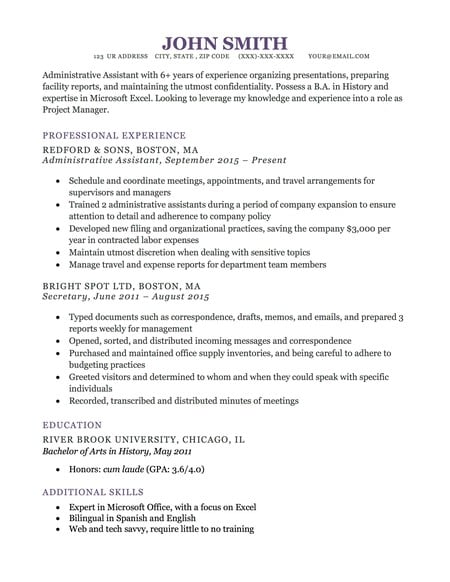
Who might use it? Anyone looking for a traditional chronological resume!
- You don’t need to include your full address (just a city and state will suffice).
- Add your LinkedIn profile alongside your other contact info so that the recruiter or hiring manager can head to your page and find additional information about your experience, see glowing recommendations you’ve received, look at work samples you’ve posted, and get excited about you as a candidate. (Just make sure your profile is updated !)
- Don’t include your GPA unless you’re a recent grad and it’s impressive.
Download it here .
2. JobScan’s Recent Grad 1 Template
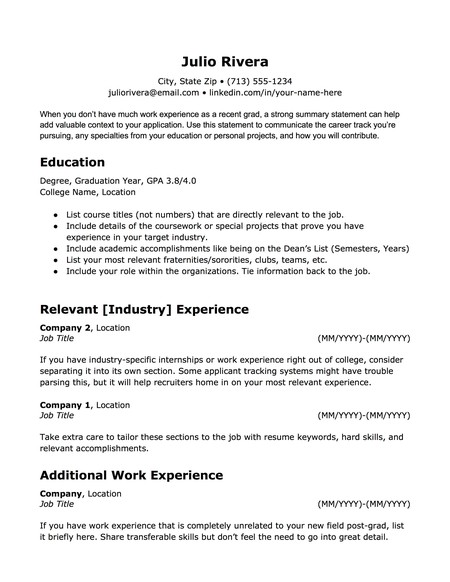
Who might use it? A recent grad who has internship or work experience that’s relevant to their target field or role as well as other experience.
- You don’t need to include your zip code.
3. Microsoft Office’s Basic Resume Template

Who might use it? A recent grad who doesn’t have a ton of work experience.
- Put your name all on one line (instead of two lines, as in the default) to ensure the ATS captures your full name.
- Try to differentiate the section headings from each job and education entry by changing the font size or style.
- Add your LinkedIn profile next to your contact info and remember you don’t have to put your full address (just a city and state will suffice).
Find it in Microsoft Word.
4. Get Landed’s ATS-Friendly Resume Template
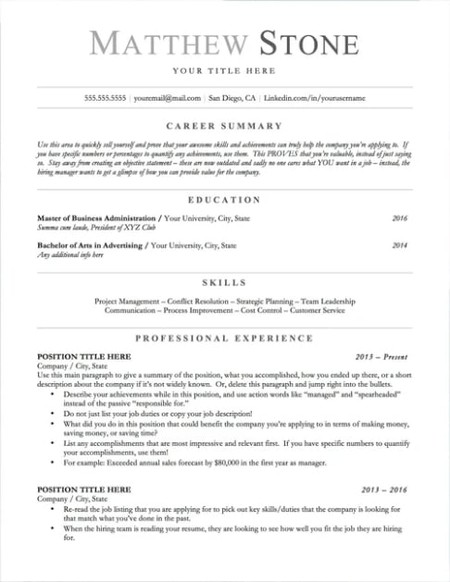
Who might use it? Someone looking for a template that could easily be tweaked as a chronological or combination resume, depending on where you put that skills section.
- Unless you’re a recent grad, you probably shouldn’t have your education up so high.
5. ResumeByRecruiters’ ATS Resume on Etsy
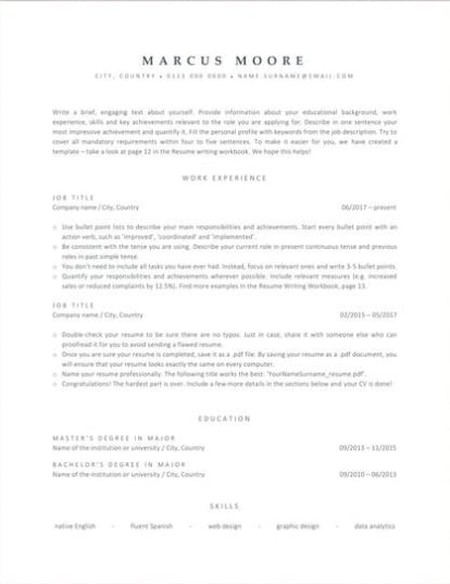
Who might use it? Someone looking for a template that could easily be tweaked as a chronological or combination resume (by moving up the skills section to the top).
- Add your LinkedIn profile alongside your contact info.
Cost: About $12
6. JobScan’s Classic Chronological and Hybrid Templates
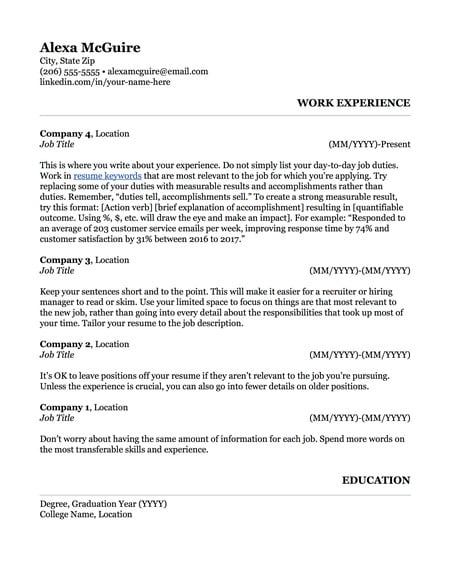
Who might use it? Someone looking for a simple template with no frills.
- Try to make sure you fit everything on one page.
Download them here .
7. Resume Genius’ White House Template
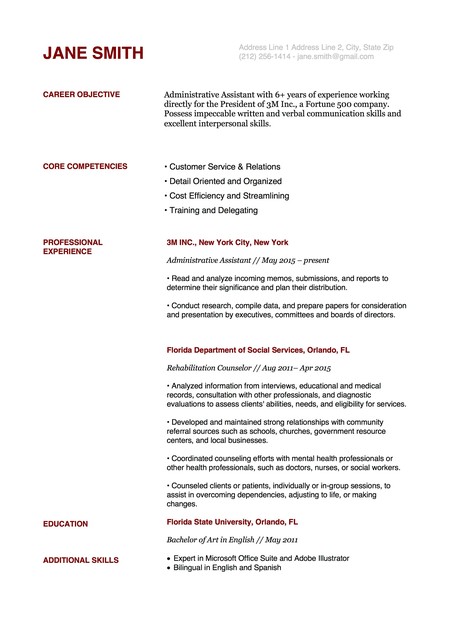
Who might use it? Someone looking for a template with a lot of white space.
- You don’t need a full address; city and state is enough.
- Add your LinkedIn profile.
- Do not use a resume objective section. You can replace that with a summary or get rid of it entirely.
Resume templates
Put your best qualities on display with professional, customizable resume and cv templates. no matter your line of work or length of professional history, you'll find resume and cv templates that'll help you get the gig..
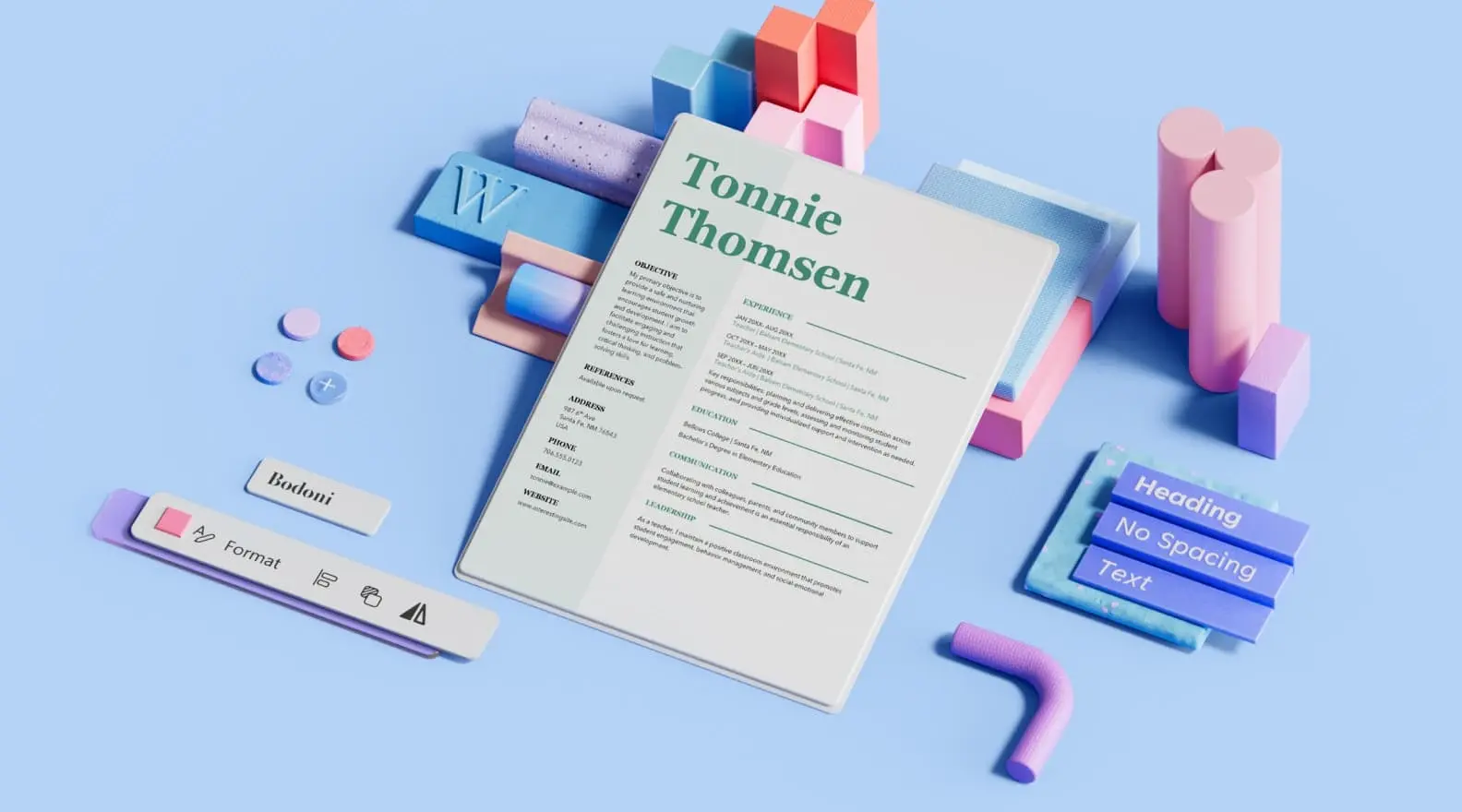
Download free resume templates
Land your dream job with free, customizable resume templates. Showcase your potential to recruiters and stand out from other candidates with a professional template. Whether you're applying to corporate positions or creative roles, go with a sleek design or show your creativity with bold colors .
Resumes don't need to look boring—add flair to your professional experience with a creative resume template. There are plenty of resume designs to choose from, like simple resume templates and modern resume templates. Each resume template is fully customizable in Microsoft Word , so you can personalize each design element and add your own text. Using a template also makes it easier to customize your resume for each position you apply to.
Print out as many copies as you'd like or download the template for free to share digitally when applying online. These professional resume templates are perfect for any stage of life or career. Whether you're a high school student, actor, or seeking a career in nursing, you can find any format for any job type.
There are also a variety of free CV (Curriculum Vitae) templates to choose from. A CV is often longer than a resume and contains an in-depth look at your education and professional accomplishments. Like our resume templates, these CV templates are also customizable in Word.
Remember, your next job is only a template away! Once you've customized your resume, explore free cover letter templates to help you land the job.
How To List Microsoft Office Skills on Your Resume (+ Examples)

3 key takeaways
- Proficiency in Microsoft Office applications is essential in most office environments.
- Tailoring your skills to match those required in the job description can improve your chances of landing an interview.
- Teal's AI Resume Builder surfaces the top tech skills and other keywords to add to your resume.
The Microsoft Office suite remains the gold standard for productivity software in the workplace.
According to Inc, Microsoft Office is the most popular app used by businesses. With over 1.2 billion users and applications like Word, Excel, PowerPoint, and Outlook deeply embedded in daily business operations, proficiency in Microsoft Office suite is more than a resume booster—it's a necessity.
Employers across industries want candidates who know how to leverage these productivity tools to streamline processes and drive results. This guide will walk you through the process of effectively showcasing Microsoft Office skills on your resume, including which Microsoft Office suite apps are worth mentioning.
Struggling to land interviews with your resume? Get started with Teal’s AI Resume Builder for free.
The importance of Microsoft Office skills
Microsoft Office, or MS Office, skills refer to the ability to efficiently use applications such as Word, Excel, PowerPoint, and Outlook for various tasks. These skills enable employees to create and manage documents, analyze data, deliver presentations, and handle email communications effectively.
Mastering these applications enhances productivity, facilitates collaboration, and supports a wide range of business operations across different industries.
Those well-versed in Microsoft Office are highly valued by employers for several reasons:
- Increased productivity and efficiency in daily tasks
- Ability to collaborate effectively with team members
- Versatility in handling various business-related projects
Mastering these applications demonstrates your ability to contribute to a company's workflow and adapt to different job duties and responsibilities.
Key Microsoft Office applications
When listing your Office skills, focus on the following core apps:
- Word: Document creation and formatting
- Excel: Data analysis and visualization
- PowerPoint: Presentation design and delivery
- Outlook: Email management and scheduling
- OneNote: Note-taking and organization
- Access: Database management (if relevant to the position)
Assessing your Microsoft Office skill level
To accurately represent your skills, it's essential to understand the different proficiency levels:
- Beginner: Basic understanding and usage of core programs in the MS Office suite
- Intermediate: Comfortable with most features and some advanced functions
- Advanced: Expert-level knowledge, including macros, VBA, and complex formulas
Evaluate your skills using these methods:
- Online skill assessment tools and quizzes
- Microsoft Office certification programs
- Practical application of skills in real-world scenarios
Basic Microsoft Office skills for a resume
If you want an office job, basic Office skills are a non-negotiable. Unless the job description specifically mentions basic Microsoft Office apps like Word and and Outlook, assume they are implied and omit them in favor of more niche software skills. The exception: if you possess advanced Word and Outlook skills that could set you apart. For instance, basic functions for data entry or mail merging set a solid foundation for administrative roles.
- Word : Document creation, basic formatting, and templates
- Excel : Data entry, basic formulas, and charts
- Outlook : Email management, calendar scheduling
Intermediate Microsoft Office skills for a resume
Once you master the basics, adding intermediate and advanced skills can significantly enhance your efficiency. Skills like advanced Excel functions and PowerPoint presentations are crucial for many desk roles.
- Excel : Pivot tables, conditional formatting, advanced charts
- PowerPoint : Slide design, animations, and transitions
- Access : Basic database management and queries
Advanced Microsoft Office skills for a resume
Mastering advanced Microsoft skills can open doors to in-demand positions. Skills like complex Excel formulas, VBA, and project management software are essential for higher-level roles.
- Excel : VBA, complex formulas, data modeling
- Project : Advanced project tracking and resource allocation
- Access : Advanced database design and management
How to choose the best Microsoft Office skills to add to your resume
Before you can list Microsoft Office skills, you need to choose the right ones to highlight. Selecting the right ones can significantly increase your chances of getting noticed by employers and passing through applicant tracking systems (ATS). Here are three tips to choosing the right MS Office skills for your resume:
Study the industry
Research the specific skills required in your industry. Different industries prioritize different Microsoft Office skills, so understanding what is essential in your field will help you highlight the most relevant abilities on your resume.
Study the company
Learn about the company's preferred tools and technologies. Each organization may have its own set of preferred software and systems, and knowing these can give you an edge in the application process. The most critical company systems and software are often outlined in the job description.
Study the job description
Analyze job descriptions to identify the most frequently mentioned skills, or use Teal's Matching Mode to automate this. Teal grades your resume based on how well it aligns to the job description and then suggesting keywords to maximize your fit. Tailoring your skills to match the job description not only showcases your job qualifications but also demonstrates your attention to detail.
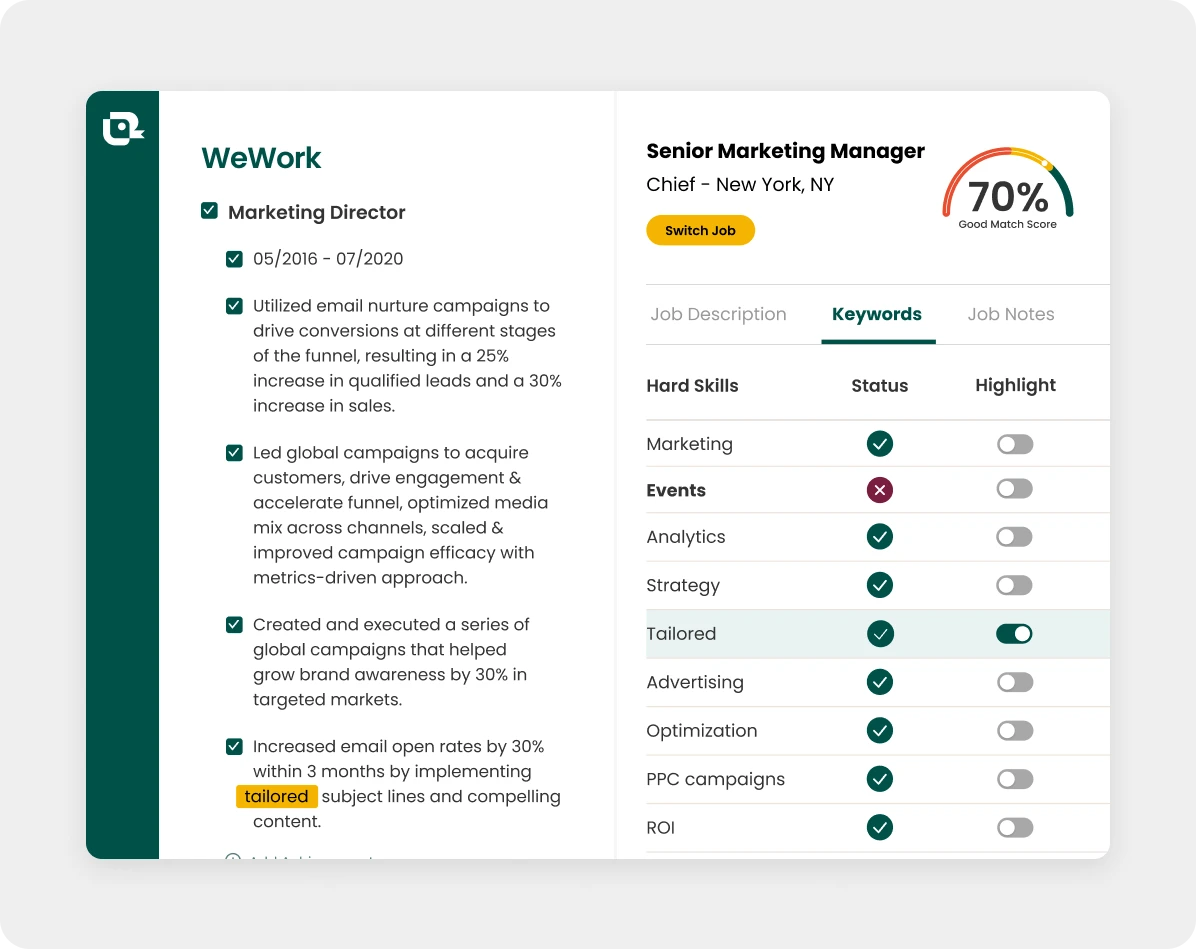
How to list Microsoft Office skills on a resume
Effectively listing Microsoft Office skills on a resume can showcase your technical expertise and make you a more attractive candidate to potential employers.
How to add Microsoft Office skills to a professional summary
Incorporate Office skills in your professional summary to complement your most notable accomplishments and technical expertise. For example: "Detail-oriented professional with 5+ years of advanced Microsoft Excel and PowerPoint experience, specializing in data analysis and compelling presentations."
Pro tip: To add skills to your professional summary using Teal's AI Resume Builder, scroll to Professional Summaries, click the drop-down button, then "Add Professional Summary." You can create one from scratch or click the "Generate With AI" button.
How to add Microsoft Office skills to the skills section
Create a dedicated resume Skills section to highlight your skills related to the job description. This section should list your most proficient and in-demand Office skills to catch the employer’s attention quickly.
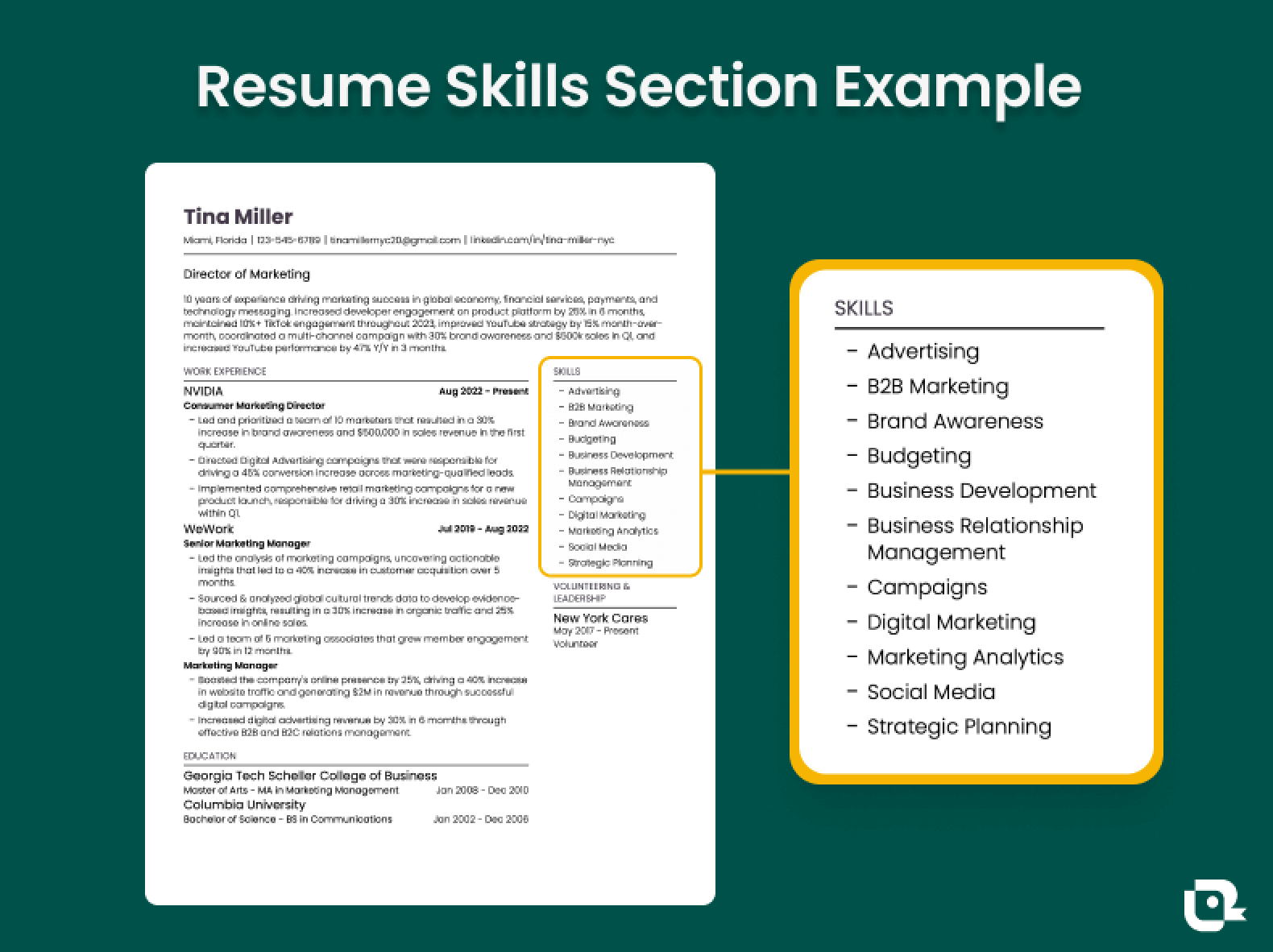
- Microsoft Word : Advanced (Expert in document formatting, mail merge, and collaboration tools)
- Microsoft Excel : Expert (Proficient in complex formulas, pivot tables, and VBA macros)
- Microsoft PowerPoint : Intermediate (Skilled in creating engaging presentations with animations and multimedia elements)
Pro tip: To add skills to your "Skills" section in Teal, scroll to Skills, click the drop-down button, then "Add Skills." Here you can list your skills individually in addition to incorporating them into a summary or achievements.
How to add Microsoft Office skills to the work experience section
Including Microsoft Office skills in your work experience achievements can illustrate how you effectively applied these skills to achieve impact.
"Developed complex Excel models that reduced reporting time by 30% and improved forecast accuracy by 15%."
Pro tip: To add skills to your work experience, from the Resume Builder, scroll to Work Experience. Click the drop-down button, then "Add Work Experience" to create a new section or "Add an Achievement" to incorporate skills into an existing work history.
Tips for adding Microsoft Office Skills to a resume
Use a skills matrix.
Create a visual representation of your skills and proficiency levels:
Microsoft Word: ●●●●○ (Advanced)
Microsoft Excel: ●●●●● (Expert)
Microsoft PowerPoint: ●●●○○ (Intermediate)
Incorporating skill bars
Use horizontal bars to indicate proficiency levels:
Microsoft Word [████████░░]
Microsoft Excel [██████████]
Microsoft PowerPoint [██████░░░░]
List skills with proficiency descriptions
Provide brief explanations of your capabilities:
- Microsoft Word: Advanced (Expert in document formatting, mail merge, and collaboration tools)
- Microsoft Excel: Expert (Proficient in complex formulas, pivot tables, and VBA macros)
- Microsoft PowerPoint: Intermediate (Skilled in creating engaging presentations with animations and multimedia elements)
Demonstrate your Microsoft Office skills with specific examples
Quantifiable Achievements
Highlight productivity improvements and showcase cost savings or revenue increases:
"Automated monthly reporting process using Excel macros, saving 10 hours of work per month and reducing errors by 95%."
Project-Specific Applications
Describe how you've applied Microsoft Office tools in specific projects:
"Created a comprehensive project management dashboard in Excel, enabling real-time tracking of key metrics across 15 concurrent projects."
Microsoft Office Certifications on Your Resume
Types of Microsoft Office Certifications
1. Microsoft Office Specialist (MOS)
2. Microsoft Office Specialist Expert
3. Microsoft Office Specialist Master
How to List Microsoft Office Certifications
Include certification names, dates obtained, and expiration (if applicable):
"Microsoft Office Specialist Expert (Excel 2019) - Obtained May 2021"
Microsoft Office skills for resume examples
It's critical to tailor skills to each job as the same role could require different skills depending on the company's tech stack.
Here are examples of how to group and list specific Microsoft Office skills for common roles:
Example 1: Accountant
- Microsoft Excel : Advanced functions and macros
- Microsoft Access : Database management
- Microsoft Word : Financial reporting
Example 2: Digital marketer
- Microsoft Excel : Data analysis and reporting
- Microsoft Word : Content creation
- Microsoft PowerPoint : Presentation design
Example 3: Administrative assistant
- Microsoft Outlook : Email management and scheduling
- Microsoft Word : Document creation
- Microsoft Excel : Basic data entry and analysis
Example 4: Project manager
- Microsoft Project : Project planning and tracking
- Microsoft Excel : Budget management
- Microsoft PowerPoint : Presentation of project plans
Example 5: Data analyst
- Microsoft Excel : Advanced data analysis and visualization
- Microsoft Word : Report generation
Using Teal’s Resume Skills Management feature, you can easily add skills to your resume, ensuring they're presented in a clear and compelling manner.
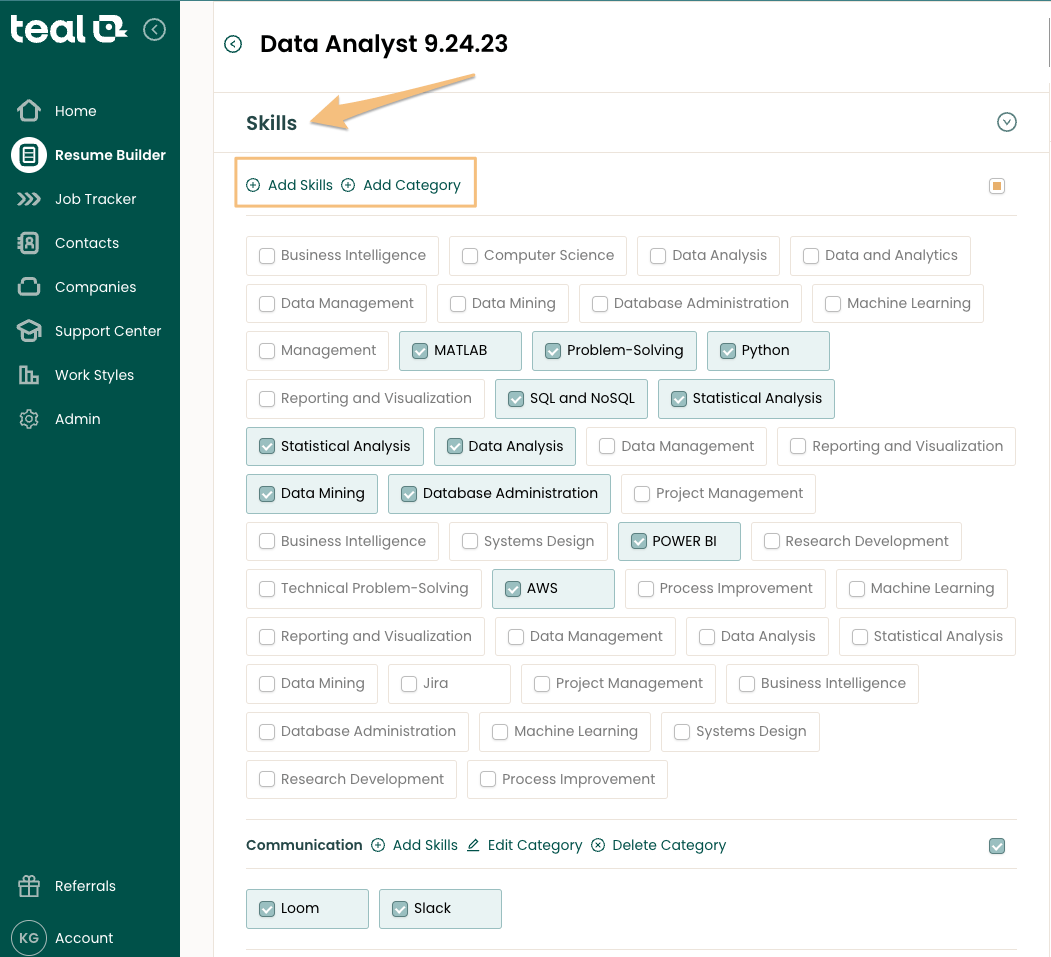
For more tips, check out this guide on adding computer skills to a resume .
Importance of Microsoft Office skills in various industries
Microsoft skills are critical in many industries. Here’s how Office skills translate into five popular sectors:
- Managing patient records with Excel
- Using Word for documentation
- Scheduling with Outlook
- Financial modeling using Excel
- Reporting with Word
- Presentations with PowerPoint
- Creating lesson plans with Word
- Managing grades with Excel
- Presenting lectures with PowerPoint
- Data analysis with Excel
- Content creation with Word
- Campaign presentations with PowerPoint
- Documentation with Word
- Project tracking with Project
How to learn Microsoft Office skills
Learning Microsoft apps is essential for staying competitive in today's job market. Here are some effective ways to learn and improve your Microsoft skills:
Online courses and tutorials
Online courses and tutorials are a convenient way to learn Microsoft skills at your own pace. Many platforms offer comprehensive courses on a wide range of topics, from basic literacy to more advanced skills in data analysis.
- Coursera : Offers courses from top universities on Microsoft Office applications.
- edX : Provides access to courses from institutions like MIT and Harvard.
- LinkedIn Learning : Features a vast library of courses on Microsoft skills.
- Udemy : Offers affordable courses on specific Microsoft Office applications.
Certifications
Earning certifications can validate your skills and make you more attractive to potential employers. Many organizations offer certification programs for various Microsoft skills:
- Microsoft Office Specialist (MOS) : Demonstrates proficiency in Microsoft Office applications.
- Microsoft Office Specialist Expert : Advanced certification.
- Microsoft Office Specialist Master : Highest level of certification.
For more certifications worth adding to your resume, check out this guide on resume certifications .
Hands-on practice
Practical experience is crucial for mastering Microsoft skills. Here are some tips for gaining hands-on experience:
- Work on personal projects : Create reports, presentations, and spreadsheets.
- Volunteer : Offer your skills to non-profits or local organizations.
- Internships : Look for internships that offer opportunities to work with Microsoft Office applications.
Free resources
There are many free resources available to help you learn and practice Office suite skills:
- Khan Academy : Offers free tutorials on Microsoft applications.
- YouTube : Features countless tutorials on how to use Office apps.
Online communities
Participating in online communities can provide support, resources, and networking opportunities:
- Reddit : Subreddits like r/Office365 offer advice and resources.
- Stack Overflow : A question-and-answer site for troubleshooting.
- GitHub : A platform for sharing Excel templates and VBA scripts.
Tips for expanding your Microsoft Office knowledge
- Set specific goals : Identify which skills you want to learn and set clear, achievable goals.
- Create a learning schedule : Allocate regular time for learning and practice.
- Stay updated : Keep up with the latest features and updates.
- Apply your skills : Look for opportunities to use your new skills in your current job.
- Seek feedback : Ask for feedback from peers or mentors.
Jobs that require Microsoft Office skills
Microsoft Office is integral to many jobs. Here are ten popular roles where key Office skills are crucial, with varying use cases:
- Data analyst : Analyzing data sets using Excel.
- Graphic designer : Creating visual aids and reports in PowerPoint.
- Digital marketer : Managing data and content using Excel and Word.
- Software developer : Documenting code and processes in Word.
- Administrative assistant : Handling email, scheduling, and document management using Outlook and Word.
- Customer service representative : Using Excel and Word to manage customer interactions.
- Financial analyst : Building financial models using Excel.
- Human resources specialist : Managing HR information systems using Excel and Word.
- Project manager : Using Project, Excel, and PowerPoint to track and present project progress.
- Medical records technician : Managing patient records with Excel and Word.
Why are Microsoft Office skills important for your career?
The Office suite encompasses a broad range of abilities that enable you to perform essential tasks efficiently. Here’s a deeper look at why they matter:
- Versatility : Applicable across various industries and roles.
- Efficiency : Increases productivity at work.
- Marketability : Makes you more attractive to potential employers.
Gaining and improving Office skills can dramatically impact your earning potential. As the demand for tech-savvy professionals grows, those with advanced Excel skills often command higher salaries and have access to a wider range of job opportunities.
Don't neglect your Microsoft Office skills
Effectively showcasing your Microsoft Office skills on your resume is crucial in today's competitive job market. By following the strategies outlined in this guide, you can significantly improve your chances of landing interviews and securing your desired position. Remember to tailor your skills to each job application, provide specific examples of your expertise, and continue developing your Microsoft Office proficiency to stay ahead in your career.
Ready to create a standout resume that highlights your skills? Use Teal's Resume Builder to craft a professional, ATS-friendly resume that showcases your expertise and helps you land your dream job.
Frequently Asked Questions
How can you prove microsoft office skills to potential employers.
You can demonstrate your skills by obtaining Microsoft certifications, providing specific examples of projects where you've used these skills, and being prepared to showcase your abilities during interviews or skills assessments.
Is it necessary to include Microsoft Office applications on your resume if you're applying for a tech-heavy position?
Even for tech-focused roles, including Microsoft skills can be beneficial. Many companies use these applications for documentation, reporting, and collaboration, so demonstrating proficiency can still be valuable.
How do you describe Microsoft Office skills?
Describe MS Office skills by listing relevant Microsoft office software in a dedicated skills section, indicating your proficiency levels, and providing context or examples in your work experience section.

Camille Trent
Related articles.

A Confidential Resume: How To Write One (+ Is It Risky?)

9 Tips for an Easy-To-Read Resume
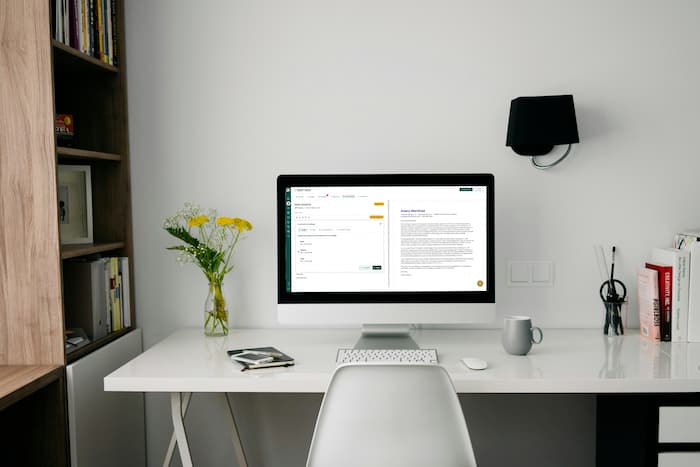
7 Best Resume Writing Services (+ Which Are Worth It)

We help you find the career dream.
- Career Centers Across UMass
- Our Newton Campus
- Handshake Login
- Student Outcomes
- Undergraduates
- Identity-Based Resources
- International Students
- Prospective Students
- UWW Students
- Post Jobs and Internships
- Host an Event
- Career Fairs at UMass
- Why Recruit at UMass
- Internship Program Best Practices
- Recruiting Guidelines
- Resource Library
- Self Discovery and Career Exploration
- Build Career Skills: Resumes, Job-searching, and Interviewing
- Learn Additional Technical, Creative, and Professional Skills
- Your Career Support Team
- Gain Experience: Internships, Co-ops, Research, and More!
- Is Graduate School Right for Me?
- Year-by-Year Checklist
- Cover Letters
- Career Fair Preparation
- Interviewing
- LinkedIn Learning
- What Skills Do Employers Want?
- Applying to Grad School
- Arts, Multimedia, and Entertainment
- Business, Financial Services, and Consulting
- Data and Information Technology
- Education, Human Services, and Counseling
- Energy, Environment, and Agriculture
- Engineering
- Government and Public Service
- Healthcare and Life Sciences
- Infrastructure and Transportation
- Law and Legal Services Career Community
- Bachelor's Degree with Individual Concentration (BDIC)
- Graduate School Office of Professional Development
- Humanities & Fine Arts (HFA)
- Information & Computer Sciences (CICS)
- Isenberg School of Management (ISOM)
- Natural Sciences (CNS)
- Public Health and Health Sciences (SPHHS)
- Social & Behavioral Sciences (SBS)
- University Without Walls (UWW)
- Connect with UMass Alumni
- Using LinkedIn
- How to Network
- Field Experience Definitions
- Internships
- Civic Engagement and Service Learning
- Internships and Co-Ops at Mount Ida
- UMass Internship Partner Programs
- Scholarships for Field Experiences
- Searching for Jobs & Internships
- Can I Do an Internship?
- Negotiating Job Offers
- Using Handshake
Resume Writing Guide
A resume is typically an employer’s first introduction to you. First impressions are crucial to establish yourself as professional, capable, and motivated. A strong resume demonstrates your transferrable skills, communication abilities, and achievements. A consistent, detailed, and concise resume can help your resume get noticed by recruiters. By formatting your resume professionally, you increase your chances of earning the interview.
Resume Components
Contact information, phone number.
Use a phone number you can answer readily, such as your cell phone. If you have a voice mail set-up, make sure it sounds professional with your name and the best times to contact you.
Your e-mail address should be professional. While you are enrolled at UMass Amherst, your UMass e-mail will work well. After graduation, consider creating a new e-mail address that contains your name.
Always include phone and email, but consider if listing your address is helpful or harmful. Employers may give preference to people who are closer geographically - if you are applying from far away, they may be unsure whether you are serious about moving.
Additionally, while your city and state are helpful to list, you do not necessarily need to include your street address. Employers will need it to hire you, but it is not required to provide during the job application process.
Objective/Summary
This section is most useful when you hand your paper resume out at a career or networking event - unless you have something specific to highlight, consider leaving it off your resume. A cover letter will do a better job conveying your why, as well as your key abilities. When you submit electronically, many Applicant Tracking Systems (ATS) will often skip the summary section and look for those key words to be in the body of your document instead.
For currently enrolled students, you will list your current degree first, and then work backwards in reverse chronological order. During your first few years of college, consider including your high school until you run out of space.
In addition to your college education, you may also highlight study abroad or domestic exchange programs . When discussing these programs, think about including the following experiences to highlight your transferable skills:
Class projects
Volunteering/internships/research applicable to your field
Independent travel
Learning to work with a more diverse group of people than you had previously been exposed to
Resolving conflicts based on misunderstandings of cultural differences
Learn new activities, languages, hobbies, or skills
Education Section Example
University of Massachusetts, Amherst (Fall 2024 - Present)
Bachelor of Arts, Major: English
GPA (if over 3.0 and you feel comfortable sharing)
Relevant Coursework: 3-5 courses max
Awards (when including awards, include the reason for receiving it. Example: "21st Century Leadership Award for high academic achievement in first year")
Senior Project: (optional)
Portfolio of work (optional)
There are many types of experiences: volunteer, paid, unpaid, work study. If the experience is relevant and taught you transferrable skills, find a way to include it.
- For each experience, include name of organization, your title or role, location, and dates
- Action verbs (samples below) to help you write accomplishment statements, which prove you have the skills you say by leaning into outcomes and successes
- Consider using multiple experience headings, such as: research experience, industry experience, or relevant experience. This can be a good way to move more relevant experiences up higher on your resume, even if they happened further in the past.
- Quantifying your work can demonstrate your aptitude. Answering questions such as "How many?", "How much?", and "How often?" will help recruiters understand the extent of your skills.
- Avoid “responsibilities included" and writing in a passive voice - using action verbs will make this easier.
Experience Example
Leverage, Incorporated: Boston, MA (September 2025 - Present)
Computer Science Intern
- Developed an algorithm that identified patterns in white collar crime in the financial industries across the United States. Implementation of this program reduced company losses by 17% compared to the previous quarter.
- Collaborated with supply chain division to design new packaging based on reduction of carbon footprint, leading to increased production distribution while reducing energy usage.
- Established a training program to help connect interns with mentors at the organization and was awarded the Innovative Intern of Quarter for these efforts
This section is typically for "hard" skills, which are skills that can easily be measured. Soft skills (such as interpersonal skills) are better described in bullet points of your experience section so they can have the context they require. For a skills section, depending on your targeted field, you may add computer, language, laboratory skills, or performances. For languages, put your level of fluency (e.g., proficient, advanced, fluent, native).
Skills Example
Computer: Microsoft Office (Word, Excel), Adobe Suite (Photoshop, InDesign), Data Analysis (R-Studio, SPSS)
Resume Formatting and Layout
The average reading only spends 20 seconds reading a resume. Before that, an applicant tracking system may be utilized to select which resumes get reviewed by a human being. Make sure your resume is easy to read and stands out.
No single format works for everyone: the only rule is that you need to be honest, factual, and relevant
One page is ideal (especially for internships) and for students ages 18-25
Keep a longer master resume for future opportunities
List everything in reserve chronological order; start with your most recent experience work backwards
Use a legible sans serif font size, keep it readable, 11 is a good place to start
1 column is better than 2; when you have two columns the reader may jump around and miss key information
No icons or images as they cannot be read by applicant tracking software
How Many Resume Versions Do I Need?
There is a big difference between customizing your resume for a specific position/industry versus creating different documents for each application.
- If you are applying to jobs in drastically different industries, you will want to customize resumes for each industry. For example, a psychology major applying to jobs in Human Services as well as Human Resources will want to highlight different experiences and skills for each, and potentially format their resumes different as a business setting holds different expectations for job criteria compared to a mental health setting.
- If you're pursuing a few different roles, but they're all related to one discipline or field, then you will not need multiple versions of your resume. However, you will still want to tweak each resume you send out based on the specific job description.
Specialized Resumes/Sections
While resumes may follow the same general format, depending on your experience and industry, there may be other considerations to help your resume stand out.
Design Resumes
Design resumes can differ from traditional resumes in several tangible ways, reflecting the unique skills and creative nature of design professions.
Your document is an indication of your style aesthetic and may not need to conform to the same rules and standards as other professions.
Visual Layout
Design resumes often incorporate creative layouts that display the designer's skills in typography, layout, and visual communication.
- Infographics: Use of icons, graphs, and other visual elements can represent skills, experience, and achievements.
- Color and Typography: Thoughtful use of color and font choices creates an aesthetically pleasing document that aligns with your personal brand.
Content Presentation and Customization
Direct links to online portfolios or examples of work, are often included as part of the resume. Incorporation of personal logos, custom icons, and other branding elements that reflect a designer's style may be added here.
File Format and Compatibility
Designers create their resumes in online spaces varying from Latec to Adobe to Canva. While many resumes are shared as PDFs, design resumes especially should be shared in this format to preserve visual integrity across different devices.
Unique Layouts
Non-traditional formats such as infographics, timelines, or modular layouts may be acceptable.
Interactivity
For digital resumes, elements of interactivity can be incorporated, such as clickable links, hover effects, and embedded multimedia.
The most important rules still apply to ALL resumes; clean neat formatting, with consistency in where the reader will access key information continues to be your driving force.
Designers should contact their career centers to discuss what resume style might best suit their professional goals.
Digital Resumes
A digital resume is an electronic version of a traditional resume that highlights an individual's professional experience, skills, and achievements using digital formats.
Either shared as a PDF or hosted on a personal website, this format allows for enhanced interactivity and multimedia integration. Digital resumes often feature creative layouts, embedded links to portfolios, and interactive elements such as hover effects or animations.
They enable candidates to visually demonstrate their technical and design skills, making them particularly popular in creative and tech industries. The goal of a digital resume is to highlight qualifications, but also provide a dynamic and engaging avenue for potential employers to assess a candidate’s capabilities.
Student Athletes
As a UMass athlete, you learn incredible transferable skills in areas such as communication, leadership, and teamwork. You also spend more time at your activity than most, so make sure they see all your greatness in action.
“Effectively managed communications between 24 team members, served as liaison connecting team and coaching staff, and effectively resolved intra-group conflicts.”
“Excellent time management skills. Balanced a 30+ hour practice, training, competition, and travel schedule while balancing full academic course load.

Cooking up a great prompt: Getting the most from Copilot
Prompts are how you ask Copilot for Microsoft 365 to do something for you — like creating, summarizing, editing, or transforming. Think about prompting like having a conversation, using plain but clear language and providing context like you would with an assistant.
1. Tell Copilot what you need
|
"Give me a concise summary of recent news about [Product X]." |
“Write a session abstract of this /[presentation].” |
|
“Check this product launch rationale for inconsistencies.” |
"Create a value proposition for [Product X].” |
|
“Create an onboarding presentation based on this /[document].” |
"What's the latest on [Project X].” |
2. Include the right prompt ingredients
To get the best response, it’s important to focus on some of the key elements below when phrasing your Copilot prompts.
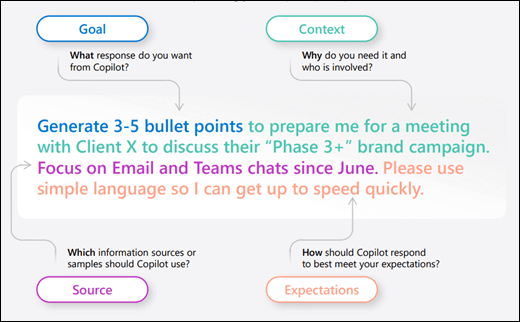
3. Keep the conversation going
Following up on your prompts help you collaborate with Copilot to gain more useful, tailored responses.
|
Lead with broader requests, then give specific details about the content. |
Ask for a summary of a specific file, then ask relevant questions to gain deeper insights. |
|
Request a meeting recap, then ask for more information about what you should know. |
Ask Copilot to translate a sentence to one of the supported languages, then ask for more context or a regional dialect. |
|
Ask Copilot to write a story, then guide it by giving more specific, relevant details. |
Present a technical problem, then narrow it down, or ask for step-by-step guidance. |
Helpful hints to keep in mind
Know Copilot’s limitations Copilot is limited to your current conversation, so give lots of details.
Be professional Using polite language improves Copilot’s response.
Communicate clearly Pay attention to punctuation, grammar, and capitalization.
Use quotation marks This helps Copilot know what to write, modify, or replace for you.
Start fresh Avoid interrupting and type “new topic” when switching tasks.
Copilot Lab

Need more help?
Want more options.
Explore subscription benefits, browse training courses, learn how to secure your device, and more.

Microsoft 365 subscription benefits

Microsoft 365 training

Microsoft security

Accessibility center
Communities help you ask and answer questions, give feedback, and hear from experts with rich knowledge.

Ask the Microsoft Community

Microsoft Tech Community

Windows Insiders
Microsoft 365 Insiders
Was this information helpful?
Thank you for your feedback.

IMAGES
VIDEO
COMMENTS
Step 3: Write an Objective or Summary. Following your title header will be your resume objective or summary. This will be a short statement between 1-5 sentences detailing your desired job title, experience, and career goals. You will want to write this statement in the Normal style.
Start by selecting "New" from the File menu. This displays the New Document task pane. You should then select "My Computer" from the Templates section on the left side of the task pane. Click on the "Other Documents" tab, and then select "Resume Wizard.".
First, click the "More" arrow on the right-hand side of the different built-in styles. You'll see a menu with three different options. Go ahead and click "Create a Style." The "Create New Style from Formatting" window will appear. The only thing you can do here is to name the style, so click "Modify."
1. Pick a template for your Word document resume. Creating a resume in Word starts with choosing the right template. Open Word and search for "resume" using the search bar in the top right-hand corner. This will bring up a range of resume templates for Word. Choose "templates" and then select the one that you like best:
In this step-by-step tutorial, learn how to create a professional and eye-catching resume in Microsoft Word. In this video, I show you how to make a resume i...
Windows macOS Web. Go to File > New. In the search box, type Resume or Cover Letter. Double-click the template you want to use. Replace the placeholder text with your own information. Start your resume with a professionally designed template and cover letter. You can use Microsoft Word resume templates to create a polished resume.
Here's what you need to do: 1 Open Microsoft Word. 2 Go to the search bar and type "resume.". Pick one of the pre-formatted resume templates that pop up. 3 Edit the filler text on the resume template with your professional information.
On the job hunt? This video shows you how to use the resume templates and LinkedIn assistant available in Microsoft Word. Here are the steps outlined in the ...
Whether you're online or offline go to FILE > New and search for "Resume.". Preview and click the one you want to open. You can start typing right away or cut and paste text into the document. After pasting old text, it might look funny, or not formatted correctly. Select Ctrl to see Paste Options and choose one like Keep Text Only.
Step #1: Pick a Word Resume Template. The first step in making a resume in Word is accessing its free resume templates. How you access the templates may change depending on the Microsoft Word version you're using, but what you ultimately need to do is the following: Open Word. Select one of the Resume templates Word suggests, or simply search ...
Learn how to create a resume in Microsoft Word from scratch with this simple tutorial. Watch the video and get tips on formatting, design and content.
Benefits of using a resume builder. Time savings: Create a professional-looking resume in minutes, rather than spending hours formatting and writing it from scratch. Professional content: Make your resume look polished and professional with suggested content. Customizable options: Easily modify the content and format of your resume to fit your ...
Creating a Resume. Let's see how you can find the right template and create a resume. Open Microsoft Word and click New . Under the search bar, click Resumes and Cover Letter. Alternatively, you can enter Resumes in the search bar. The templates are displayed. Browse the list and click the Pin option to mark a few templates for future reference.
Type the title on a line by itself and, like your name, put it in all caps, small caps, larger text, and bold text so that it stands out from the rest of the words on the page. It's also a good idea to center it on the line. You can also change the color. Some rules to use when applying color to your resume:
Add a Resume Objective/Summary. Double space from the last line in your resume header. Write "Objective" or "Summary" depending on which one you're using. As it's a section title, make it a little larger than the rest of the text (14-16 pt). Also, depending on the font you're using, make it bold.
Let's dive into the step-by-step process, and soon you'll have a resume that's sure to impress. How to Make a Resume on Word. Creating a resume on Word will help you professionally present your skills and experience. Here are the steps to design a standout resume: Step 1: Open Microsoft Word. Open Microsoft Word to begin your resume.
Here's everything you need to know about finding, picking, and using Microsoft Word resume templates—plus a few examples of templates you can use for free (or cheap!). ... How to Use a Template to Make a Resume in Word. Okay, so you've found a template or two that you really like and you're ready to sit down and make your resume. What ...
Step 2: Choose a Word resume template. When you open Word, you'll find suggested resume templates. The first suggestions are just a few of the available options in Word. If you search for "Word resume templates," you'll find many more available to use.
Add your personal info to the résumé. On the Home tab, select New Items > More Items > Choose Form. Set Look in to User Templates in File System. Locate and select the template you created earlier, then choose Open. Customize the template with content about yourself. Add recipients to the message, then select Send.
Learn how to easily create or customize a resume or CV with the help of Microsoft Word. Especially powerful is the Resume Assistant that is part of Microsoft...
Download free resume templates. Land your dream job with free, customizable resume templates. Showcase your potential to recruiters and stand out from other candidates with a professional template. Whether you're applying to corporate positions or creative roles, go with a sleek design or show your creativity with bold colors.
1. Start with a header. This element can list your contact information, including your first and last name, email address and phone number. Depending on the template you select, this information is often bold and centered at the top of your resume. Simply add your information to the template by clicking each line and typing the required contact ...
Basic Microsoft Office skills for a resume. If you want an office job, basic Office skills are a non-negotiable. Unless the job description specifically mentions basic Microsoft Office apps like Word and and Outlook, assume they are implied and omit them in favor of more niche software skills. The exception: if you possess advanced Word and ...
Template is available for download: https://xamplio.com/career-resourcesWant me to edit your resume? Head to https://xamplio.com/resume-servicesThis video sh...
Just browse its collection, click on a design you like, and select the Word button under Download Free Template.In the next window, hit Free Download.If you're not signed in already, you'll be ...
This section is most useful when you hand your paper resume out at a career or networking event - unless you have something specific to highlight, consider leaving it off your resume. A cover letter will do a better job conveying your why, as well as your key abilities. When you submit electronically, many Applicant Tracking Systems (ATS) will often skip the summary section and look for those ...
Check out my updated video: https://youtu.be/9AL0LRim4LsFREE resume templates on my site: https://xamplio.com/career-resourcesThis video shows how to make an...
Prompts are how you ask Copilot for Microsoft 365 to do something for you — like creating, summarizing, editing, or transforming. Think about prompting like having a conversation, using plain but clear language and providing context like you would with an assistant. 1. Tell Copilot what you need
Welcome back to our Channel How to create a resume in MS Word (in details) :- https://youtu.be/M6l2jqFs1Q8CAREER OBJECTIVETo take up a challenging career an...